Who doesn't love a good pet story? We sure do and we'd like to share some of ours with you! These pets underwent treatments, fought to get better and came out on top!
Bella Martin
Bella presented for losing weight back in August of 2023. Her owners tried feeding her canned dog food for the extra fat and protein to help with weight gain, but with no success. Dr. Reese recommended a senior blood panel which showed abnormal sodium potassium ratios, leading Dr. Reese to suspect Addison’s Disease. Bella then came back in the following day for an ACTH Stim Test to confirm his suspicions. The ACTH stimulation test mimics the natural stimulatory pathway and demonstrates the capacity of the pet’s adrenal glands to produce cortisol in response to an injection of synthetic ACTH (adrenocorticotropic hormone). In a dog with normally functioning adrenal glands, the injection should cause a significant increase in cortisol. In Bells’s case, the cortisol levels stayed very low. Dr. Reese then prescribed monthly Percortin injections and Prednisone to treat the Addison’s Disease. Bella came back in early January for a re-check appointment and she is doing very well. She has gained some weight back and is feeling so much better. Her treatment is lifelong, but as long as she receives her injections, she’ll be able to live her life to the fullest.
Snake Bite!
On 11-09-2022 two French Bulldogs, Boomer and Bella, presented at our clinic with probable snake bites: unfortunately Bella succumbed to her injuries shortly after arrival. We began treating Boomer aggressively with anti-biotics, anti-inflammatory, and anti-nausea medicines. We placed and Iv catheter and began pushing fluids to assist in clearing the venom from his system. We ran bloodwork, urinalysis and used the sonogram to look for fluid in the abdomen, but were struggling to stabilize him as he continued to vomit blood. We had no anti-venin and gain control of Boomer’s clotting and vomiting issues. Boomer was a hard fighter and after a couple of days of being hospitalized, he was able to go home. A week later, Boomer returned for a checkup and, although his face was still swollen, he was in great spirits. Boomer is a very lucky dog.
Please be aware of snakes and the areas in which they live; monitor your pets around those areas in particular. Most veterinary clinics do not keep anti-venin in stock as it has a very short shelf life and is expensive. At Whitehouse Veterinary Hospital, we do carry the rattlesnake vaccine which is helpful for pit viper and other common snake bites. While most snake bites are not as serious as the ones sustained by Boomer and Bella, it is always a good idea to consult your veterinarian if you have any questions or concerns.
Beautiful Bane
The culture results showed that Bane was fighting a really bad bacteria and needed to be on two different antibiotics. Since starting these antibiotics Bane’s infection has cleared up and he is back to his normal happy life.
The Great Gizmo
Gizmo first came to see Dr. Ochoa for issues with his hind legs and back. Dr. Ochoa suspected that our ferret friend had injured his back somehow and recommended an x ray to make sure that there wasn’t anything more serious going on. To our surprise the x ray showed that Gizmo had a large bladder stone along with a back injury. We first started Gizmo on medication and strict cage rest to let his back injury heal. After he had recovered from is back injury, Dr. Ochoa performed surgery to remove the large stone from his bladder. Gizmo has now recovered from his surgery and is living the best life with his parents and other ferret friends.
Perfect Patrick

In male cats, urinary blockage can commonly reoccur. There are many things that you can do at home to help your male cat not have a urinary blockage such as:
- Feeding a urinary diet
- Having 1 more litter box than you do cats
- Give Dasaquin: a supplement that helps decrease the inflammation of the bladder lining.
- Using calming agents such as Feliway if your cat is stressed.
- Providing toys and other stimulants to help your cat lose weight.
If you cat is not urinating or having any other urinary issues, please contact us right away. We can discuss things that your can do to help your cat live a long and healthy life without having reoccurring urinary issues.
Taz Craig
Meet Taz! Taz is a two year old orange tabby cat whose owner became very concerned about him when she noticed that Taz had stopped eating, was acting very lethargic, and had a bloated abdomen. Taz’s concerned owner made an appointment to bring him to see Dr. Ochoa right away. Upon physical exam, Dr. Ochoa noticed Taz seemed depressed and lethargic, his gums were extremely pale, and he had a pendulous bloated abdomen. That made Dr. Ochoa suspicious that Taz had a large amount of fluid in his abdomen. Dr. Ochoa quickly realized there was something serious going on and that his life was in danger. Taz’s owner was willing to let us do whatever we could to save her beloved pet so we started with bloodwork and an abdominal ultrasound for diagnostic testing. Taz’s bloodwork showed that he had extremely elevated liver enzymes that were almost ten times the normal level and that he was dangerously anemic - meaning his red blood cell count was dangerously low. This let Dr. Ochoa know that Taz needed a blood transfusion immediately or we could lose him at any moment. We then performed an abdominal ultrasound which revealed a large mass on his liver and a large amount of free floating fluid in his abdomen. Dr. Ochoa extracted some of the fluid from Taz’s abdomen only to discover all the fluid was blood. It all made sense now. At only two years old Taz had a mass on his liver that was causing him to bleed out internally. Dr. Ochoa explained to Taz’s concerned owner that without a blood transfusion and immediate surgery he would not survive much longer. Taz’s owner wanted us to try everything we could in attempt to save his life, so we immediately started to give him a blood transfusion with blood donated from an employee’s own cat. Once in surgery Dr. Ochoa suctioned out almost two liters of blood allowing to her to see the mass on his liver that was the size of a grapefruit, and that this mass was also attached to his vena cava; which is the largest artery in the body. Dr. Ochoa understood that if this artery has even a small nick or puncture then Taz could bleed out and die in matter of seconds. She wisely asked Dr. Reese to assist her with trying to remove the mass without harming the vena cava. Dr. Ochoa and Dr. Reese worked together to very carefully dissect the mass off of the vena cava and remove it from the liver, remarkably leaving Taz’s entire liver and vena cava intact. To everyone’s relief, Taz recovered from surgery and starting eating again that same evening. The following days, he continued to eat and improve. Dr. Ochoa and Dr. Reese sent off the mass to a diagnostic lab to be biopsied. Although Taz was doing great, our doctors were still concerned that the large fluid filled mass was potentially cancerous. Taz’s owner and our entire staff were elated to find out a few days later that the mass was just a benign fluid filled cyst and that Taz did not have cancer! Thanks to the entire Whitehouse Veterinary staff and Taz’s owner for never giving up. It is now several months later and Taz is living a happy and healthy life like any normal two year old cat should!
Super Max
We have seen many pets come into our hospital that have tangled with another pet and gotten hurt pretty badly. The worst we had seen for the year was Max. Poor Max was rushed to the hospital after he had been attacked by a neighborhood dog and was very badly injured. He had a laceration across his chest, broken ribs, a broken leg, and was in terrible respiratory distress. Dr. Reese, Dr. Ochoa, and the entire staff very quickly assessed Max and started treating him for these life threatening injuries. The prognosis was poor, given his condition but his owner knew he had so much life in him and wanted to give him the very best chance possible. He had a chest tube placed to remove any air and fluid in his chest, his lacerations were repaired and his leg was splinted. His fractured ribs where stabilized with a wide splint wrapped on the outside of his chest and sutured against his body to keep it in place. He had gauze and a mesh wrap to protect it from the elements. For the first few days, Max was in critical condition and closely monitored around the clock, with his chest needing to be drained of air and fluid every few hours. Our great technician’s, Ami and Jodi, they took great care of Max even after hours, taking him home with them in turn so he would never be alone. A few days into his recovery, Max made an amazing turn around and started showing his happy loving personality. After a visit with his mom, he tried to jump up and follow her out of the room. We knew then, without a doubt, he was going to be just fine. Max had to keep his leg and chest splint for 8 weeks and did very well. Unfortunately, we saw during that time that his leg was not going to heal due to the severity of his fracture. After he was mostly recovered he had to have his front leg amputated, which went very well. He didn’t even seem to notice the difference! Max has since recovered from his fight and is living a happy, rambunctious life with his mom.
Wonder Stitt

Meet Wonder, a two year old German Shepherd who has been a beloved member of her family since she was a young puppy. Wonder has been a happy and healthy dog until recently, when she started to present chronic GI symptoms and weight loss. Her owners took her to their local veterinarian in the Dallas where they live. She had an examination and general testing to hopefully explain her symptoms and rapid weight loss. When testing didn’t provide an answer for her symptoms, she was prescribed medication to treat her symptoms in hopes that her issues would resolve and she would quickly recover. Unfortunately, Wonder continued to lose weight, have vomiting and diarrhea. Her owners became increasingly concerned and she was referred to a specialist in the area. Wonder and her owners visited the specialist where several tests were performed, including blood panels, urinalysis, fecal testing, and physical examination. Although there were slight abnormalities in Wonder’s bloodwork results there was still no clear answer as to what was making her sick. With the bill getting increasingly higher, the choice was made to try a new regimen of medication prescribed by the specialist in hopes that they would cure her illness. After some time on the new medicine, Wonder continued to suffer from chronic GI symptoms and weight loss. Her owners were incredibly worried now and reached out to a family friend who is a technician here at Whitehouse Veterinary Hospital to get a personal opinion. After looking over the lab results and considering her symptoms, he reached out to Dr. Ochoa and asked her to review the results, as it seemed to be a very complicated case. After reviewing the test results she requested that Wonder’s owners make the trip from Dallas to Whitehouse so she could do a work up of her own as she had some suspicions as to the cause of her symptoms. Wonder’s owners agreed and they set up an appointment. Luckily, Dr. Ochoa had just taken a part in an education meeting with a veterinary GI specialist and, armed with the most current information on GI illness, Dr. Ochoa decided to run specialized tests. Wonders’ owners were desperate for an answer and agreed. A few days later, we received results from the lab confirming Dr. Ochoa’s suspicions and diagnosing Wonder with a disease called exocrine pancreatic insufficiency, also known as EPI. Epi is a condition where the pancreas does not secrete enough digestive enzymes to properly break down and digest food. This results in the inability to digest and absorb nutrients, causing GI symptoms and weight loss often in young animals. Elated that we have a diagnosis, Dr. Ochoa prescribed the proper medications and supplements to treat EPI. Although EPI is a chronic and incurable disease, it is easily manageable and with the proper care Wonder can go on to live a long, happy, and healthy life. Just two months after Wonder’s visit with Whitehouse Veterinary Hospital, her relieved owners reported that she has gained 15lbs and is no longer experiencing GI symptoms. Thanks to Dr. Ochoa, the staff at Whitehouse Veterinary Hospital, and Wonder’s caring owners, she is now well on her way to recovery.
Pheobe Brooks
Phoebe is a chihuahua mix that came to us presenting with neck pain in August of 2018. She didn’t want to jump up like usual, and during her physical exam she was tense when her neck and abdomen were palpated. Dr. Ochoa recommended blood work and radiographs. At the time, we were only able to do blood work, which turned out to be mostly normal. Dr. Ochoa sent Phoebe home with a muscle relaxer, anti-inflammatory medication, and instructions for Phoebe to rest. She started to improve on the medication and then relapsed a few weeks later. Phoebe now presented with a stiff neck and the inability to walk. Dr. Reese recommended treating Phoebe for possible meningitis or a tick born disease. Over the next few days she improved significantly with the treatment of an antibiotic and muscle relaxer. Dr. Reese sent her home with instructions to continue with the muscle relaxer and antibiotics and to start steroids. With medication and cage rest, Phoebe started to improve and was now walking normal again and had started to return to normal activity. A few weeks went by and Phoebe relapsed, unable to walk well, in pain, and then started to have seizures. Dr. Ochoa sent her home with some pain and seizure medication and with instructions to restrict her activity level. Phoebe was diagnosed with possible Granulomatous Meningoencephalitis or also known as GME, a neurologic disorder. With the hard work of Dr. Ochoa and Dr. Reese, Phoebe improved with medication and was back to her normal happy self
Westley Williams
Westley is a six year old Daschund mix who came in to see us in June of 2018 with back issues. He was having trouble getting up and around every few days and was starting to eat less than usual. Dr. Ochoa recommended radiographs so she could determine what the problem was. After radiographs showed inflammation in his joints Dr. Ochoa prescribed muscle relaxers and pain medication, along with strict cage rest to hopefully allow him to recover over a few weeks. Unfortunately, though he did initially seem to respond to treatment, he had a setback a couple of months after. In August, he was brought back in for weakness, weight loss, and loss of appetite. It was recommended that he stay on his muscle relaxers and to limit his movement. Unfortunately, as time passed our doctors saw that Westley wasn’t responding to medications and further tests were needed to determine the cause of his symptoms. He returned again in December with the same issues and dehydration. Dr. Reese recommended bloodwork and some additional tests but the results were unremarkable which led the doctors to suspect that a tick borne disease might be the cause. They prescribed a round of steroids and antibiotics which tick borne diseases respond to and sent him home. After beginning the medicine, Westley started showing improvement! We had high hopes that this was the answer to Westley’s problems. We rechecked him after being on the medication for two weeks and he was still improving so we planned to let him finish with the current round and slowly wean off the steroids. As he was finishing the steroids, he started the decline in health once more. This brought the doctors to suspect that instead of a tick borne disease, they were dealing with a disease called Immune Mediated Polyarthritis. This is a condition where the body’s white blood cells start attacking the joints, causing inflammation and pain. This is generally treated with steroids, which Dr. Reese prescribed again and Westley responded well! Over the next several months Westley underwent steroid therapy and has been steadily improving. With this particular issue, steroids may possibly be a life-long treatment used to alleviate the symptoms and give Westley the best quality of life. We wish Westley and his family the best and are happy that he is in such good hands!
Annie Adams
Meet Annie a five year old blue heeler mix. Annie was brought in to Whitehouse Veterinary Hospital when her owners noticed she seemed to be in pain and was not acting like her normal happy self. Annie’s physical examination began with a discussion to get an accurate history and description of Annie’s symptoms. Upon further examination Dr. Ochoa took note that Annie was running a fever of 104.2 degrees and her abdomen was distended and painful upon palpation. It was also noted that Annie had some bloody fluid coming from her vulva. With careful consideration of Annie’s history, symptoms, and the fact that Annie had never been spayed Dr. Ochoa explained to Annie’s owners she was highly suspicious of a serious uterine infection called a pyometra. Since a pyometra infection can be potentially life threatening Dr. Ochoa recommended that we immediately run bloodwork and perform an abdominal ultrasound to confirm her suspicion. These test confirmed Doctor Ochoa’s suspicion and the decision to admit Annie for emergency surgery was agreed upon. Without emergency surgery Annie’s prognosis was poor and the chance of her becoming septic or having her uterus rupture with fatal consequence was too high to risk. Annie’s owner agreed to let us perform emergency surgery to give her the best chance for survival. Dr. Ochoa performed an emergency ovariohysterectomy during which Dr. Ochoa discovered Annie’s uterus and ovaries were severely infected and swollen. Dr. Ochoa carefully proceeded to surgically remove the reproductive organs to clear Annie’s body of the serious infection and prevent this from happening again in the future. The surgery was performed successfully and after a couple more days in the hospital on IV fluids and powerful IV antibiotics Annie was in good condition and spirits and was able to go home with her owners. Upon follow up examination Dr. Ochoa was relieved to report to Annie’s owners that she had made a full recovery and was given a clean bill of health. Pyometra infections are serious and potentially life threating and this is one of the many reasons we recommending getting your female dogs spayed at around 6 months of age. Spaying and neutering your pets not only prevents unwanted pregnancy but also has many health benefits such as prevention of life threatening diseases or infections. Annie is fortunate to have attentive owners who know her well and love her. Thanks to her owners and the staff at Whitehouse Veterinary Hospital Annie is healthy and happy and loving life at home with her caring owners.
Icharis Biddle
Meet Icharis Biddle! Icharis is an 8 year old short hair cat who came to see us because he had had trouble with vomiting. It had been on and off for a few months and after first trying to get him better at home with medication and low-fat food, Icharis came in when he started vomiting multiple times a day. Poor guy was not feeling well and needed some special help. Dr. Redding decided we needed a better look at what was going on with Icharis and suggested a blood panel. The panel showed that Icharis was fighting a slight infection and was a little dehydrated. He went home with more medication and a new special diet to try to alleviate the symptoms. That night he became very sick and went to the emergency clinic for treatment. He was transported to our hospital the next morning where Dr. Redding performed radiographs and ultrasound. During the procedure she found that his stomach was quite enlarged. It was determined that Icharis needed exploratory surgery to see what this was and if it was causing him to continue to vomit and lose weight. During surgery a large mass was found and was removed along with a few inches of intestines. After this he was hospitalized for a few days while he recovered from his surgery until he started eating on his own and stopped vomiting. The mass was sent off to a lab to be tested and unfortunately was found to be cancerous. For now, Icharis is being cared for at home and has a special regimen of medicine to help his nausea and to help decrease the size of the cancer cells. He’s also being fed a diet that is easy to digest so that he can continue to be comfortable. He seems to be doing well and being taken care of by his loving family.
Jack Hankins
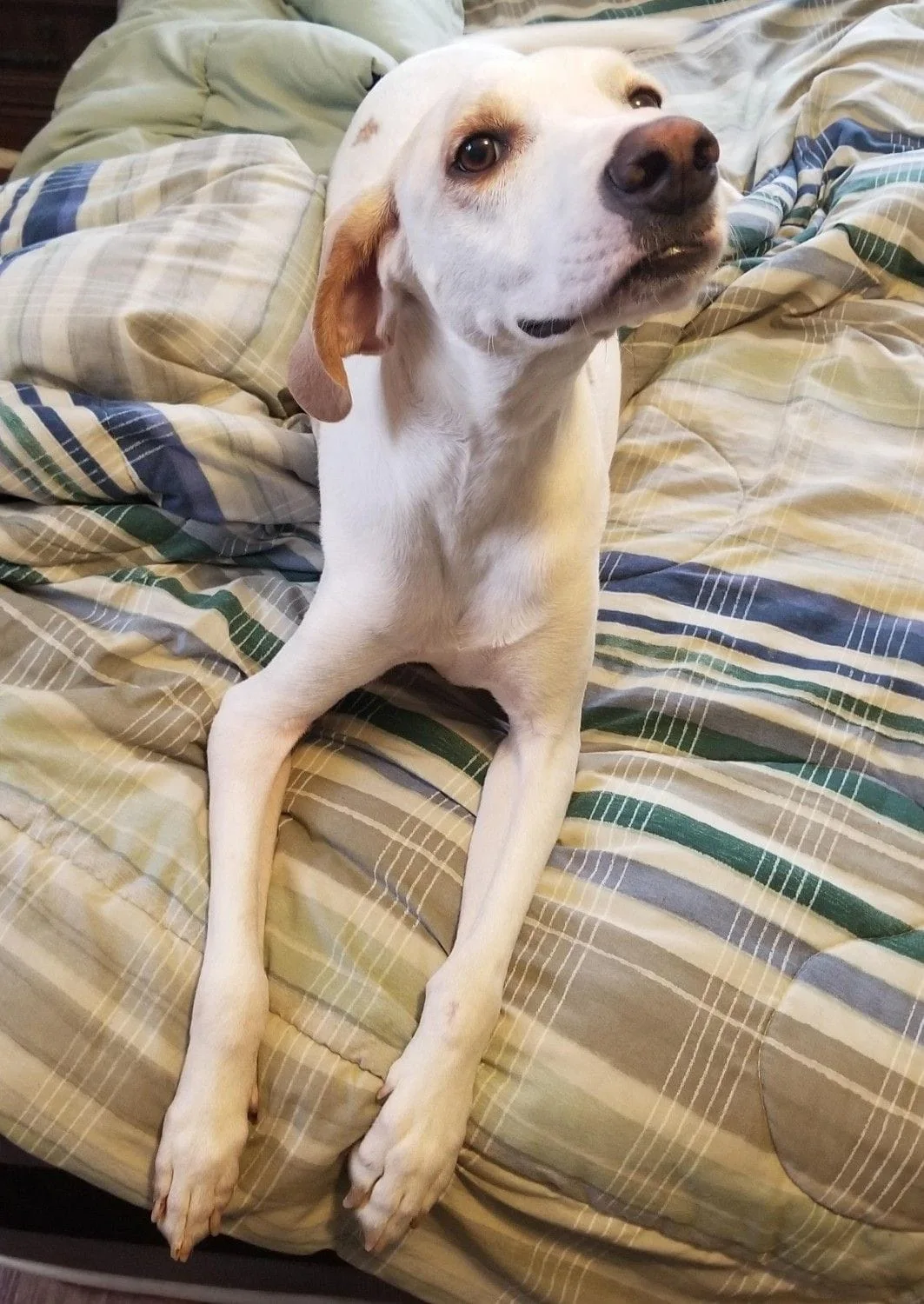
Meet Jack, a three year old hound mix who was rushed into Whitehouse Veterinary Hospital by a kind hearted police officer who found him after being hit by a car. Jack arrived in critical condition and was quickly examined by Dr. Reese to evaluate the extent of his injuries. Upon physical exam it was apparent that jack was in shock and had several superficial lacerations, severe bruising, and suspected broken bones as a result of the trauma. Further diagnostics were also needed at this time to rule out potentially life threatening internal injuries. The Whitehouse Veterinary Hospital staff immediately began treating jack with IV fluids and injectable drugs to help bring him out of shock, follow by an ultrasound scan of his chest and abdominal cavities which to everyone’s relief showed jack did not have internal bleeding in his chest or abdomen. Once Jack was out of shock and in a more stable condition a few hours later he was then sedated so his lacerations could be sutured closed and x-rays could be performed without him feeling any discomfort. As suspected the x-rays revealed that Jack had several fractured bones in his paw, as well as a fractured elbow and fractures to his pelvis in three different places. By this time Jack’s concerned owners had already been identified and contacted and the decision was made to splint and stabilize Jack’s front leg so that the fractures in his paw and elbow could heal. The fractures in his pelvis would heal with time and strict cage rest. Jack was also prescribed pain medicine to help keep him comfortable and antibiotics to help prevent infection. It was evident that Jack had a long road to recovery but with diligent care from his owners and the Whitehouse Veterinary Staff he is now on the mend and doing well a few months later. Special thanks are given to the police officer who played a major role in saving Jack’s life by finding him and rushing him in to our hospital for emergency care. The heroic officer continues to stop in from time to time to get updates on how Jack’s recovery is going and we are all glad to know that Jack is doing well and is happy at home with his loving family.
Abbi Glasco
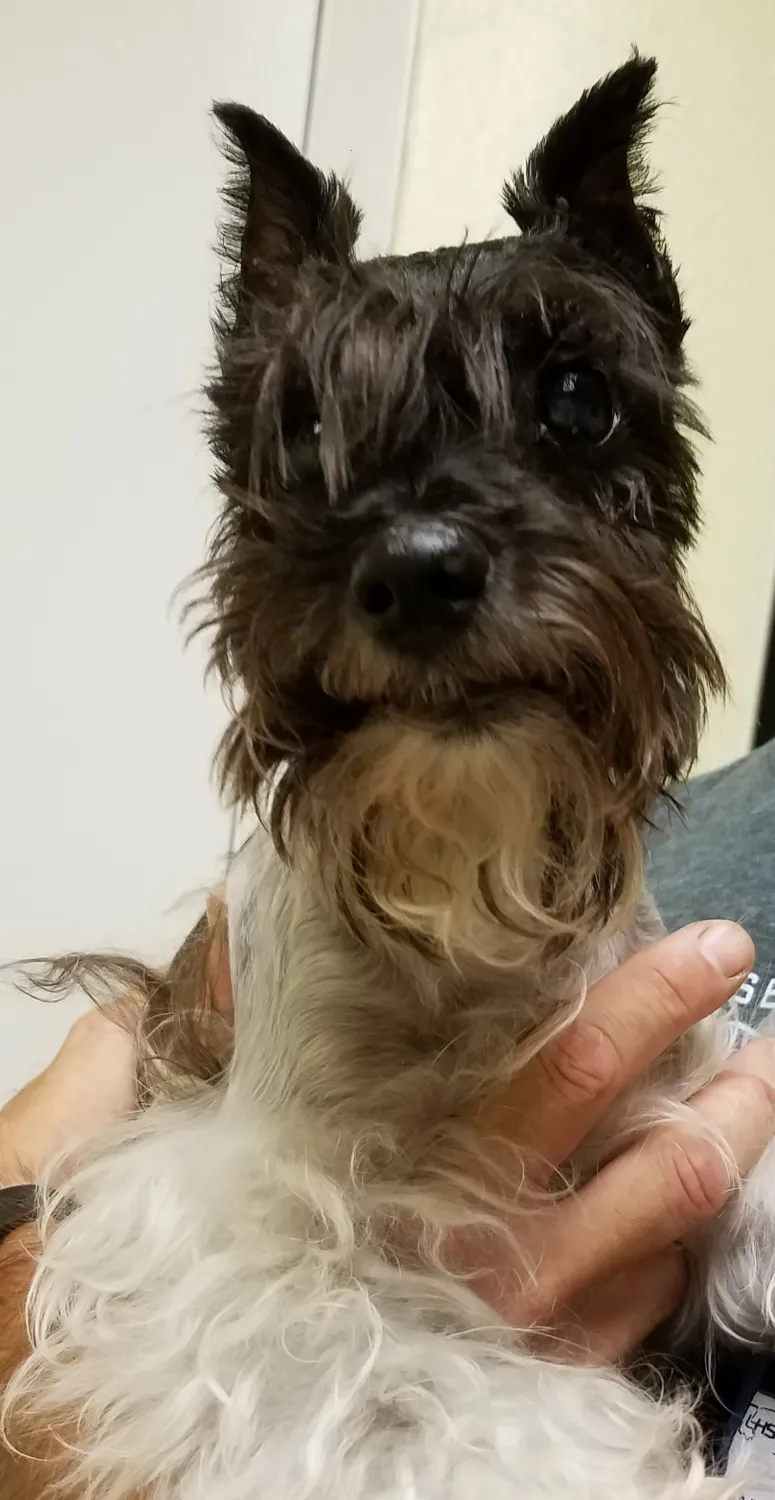
Meet Abi, a 13 year old miniature schnauzer with a sweet personality and a touch of attitude. Recently, Abi was brought to us by her family because she was experiencing hind leg paralysis. Dr. Reese ordered x-rays and determined that Abi had developed intervertebral disc disease (IVDD) in her neck and the thoracolumbar section of her spine. In short, the spaces between several of her vertebrae had become compressed to the point that the intervertebral fibrocartilage, commonly known as discs, had become displaced, resulting in pressure on the spinal cord and associated spinal nerves. In Abi’s case, the resulting symptoms were discomfort, pain, and paralysis of her hind legs. Dr. Reese determined the feasible options for treating Abi and discussed them in detail with her family.
One option was surgical correction in which displaced disc material would be removed in order to take pressure off of the spinal cord and the associated spinal nerves with the goal of alleviating the resulting symptoms of discomfort, pain, and paralysis. A second option was a regimen of medication, laser therapy, and strict cage rest, to promote healing and regain function in her hind legs. Abi’s family committed to the second option.
Treatment began with a protocol of prescription pain relief, anti-inflammatory, and muscle relaxing medications. These were coupled with therapy laser treatments which promote reduced pain and inflammation, increased blood flow to the targeted areas of treatment, and enhancement of the healing process to those same areas. Strict cage rest was also prescribed and vital to Abi’s treatment.
Abi’s family followed the doctor’s instructions with unfailing dedication and consistency. Medications were given in precise, measured, doses and time intervals. When Abby didn’t want to eat, they syringe fed her the diet prescribed by Dr. Reese in order to keep her strength up and lend to the healing process. They limited her physical activity with cage rest exactly as directed and for the first few weeks, they brought Abi to our hospital every other day for laser therapy. When these days fell on Saturdays or Sundays, when we don’t have normal office hours, we made arrangements to meet them at our hospital to provide for Abi’s laser therapy. Over time, Abi began to regain function in her hind legs and her appetite returned.
Today, several weeks after beginning treatment, Abi has regained almost full function in her hind legs. She eats and drinks healthy portions of food and water and has even regained a little body weight. Her laser therapy sessions have been scaled back to once per week and she relies much less on prescription medications. Her quality of life is very near to what she experienced before her onset of IVDD, and her family is delighted with her progress and much less worried for their family dog. Abi’s weekly visits to Whitehouse Veterinary Hospital are highlights for the entire staff. We all find the time to check in on Abi and observe her progress. Abi’s family and their commitment and diligence are wholly responsible for her amazing recovery. Success stories like Abi’s and our opportunity to be a part of those stories are why we enjoy what we do so much!
Brammer Newton
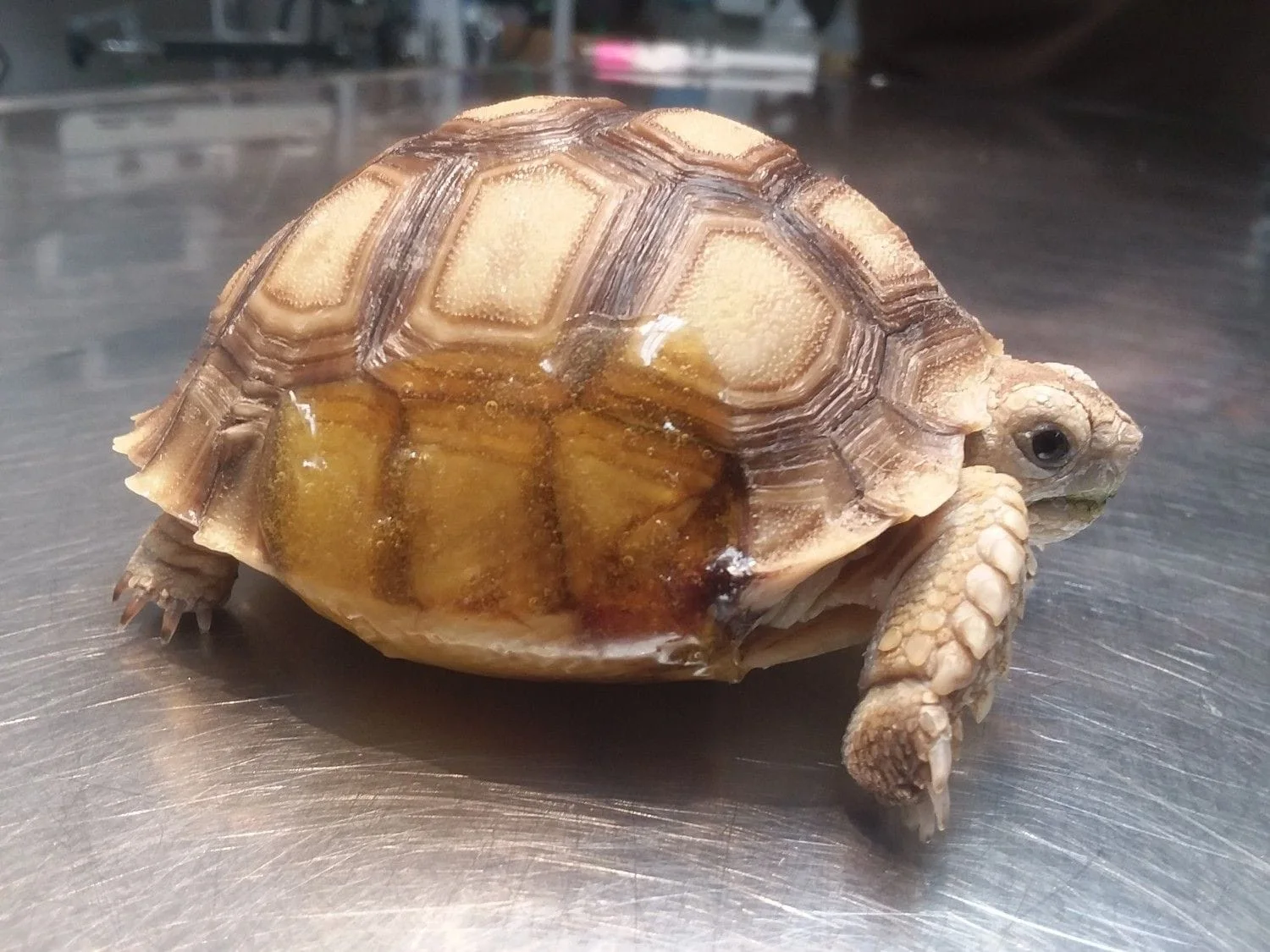
Meet Brammer Newton! Weighing only 90 grams and measuring a few inches long, this tiny baby was minding his own business walking around at home when the family dog thought he found a new toy! Unfortunately for Brammer, being as young as he is, his shell provided little protection against dog teeth when the pup tried to get him to squeak. He suffered a crack to his shell and a puncture wound and was very distressed by the entire ordeal. He drew himself inside his shell as much as possible and stayed there. When his owner had rushed him to us he was slightly cold and not willing to come out. Unfortunately, we can’t force him out of his shell and it was a tough call at the time to tell if he was even alive. The best thing to do at the moment since the bleeding had stopped and the bites weren’t too severe was to have him placed under a heat lamp for a couple of hours and get him warmed up so we could work on him. Once he warmed up he was willing to say hello to everyone and we were able to get him started on antibiotics and work on repairing his shell.
The shell repair is important because the wounded area needs to be protected as it takes a couple of years for it to completely heal. The repair is a two part process, the first providing stabilization and protecting the wound from outside infection and the second a resin seal that waterproofs the area so when a turtle swims or a tortoise soaks it won’t allow water to seep into their abdominal cavity. This repair will last them a long while and as they grow it will eventually fall off. Brammer was very patient with us with each visit and took all the handling and oral meds like a little champ. He’s doing well now and toddling around like nothing happened!
Orion Hanson
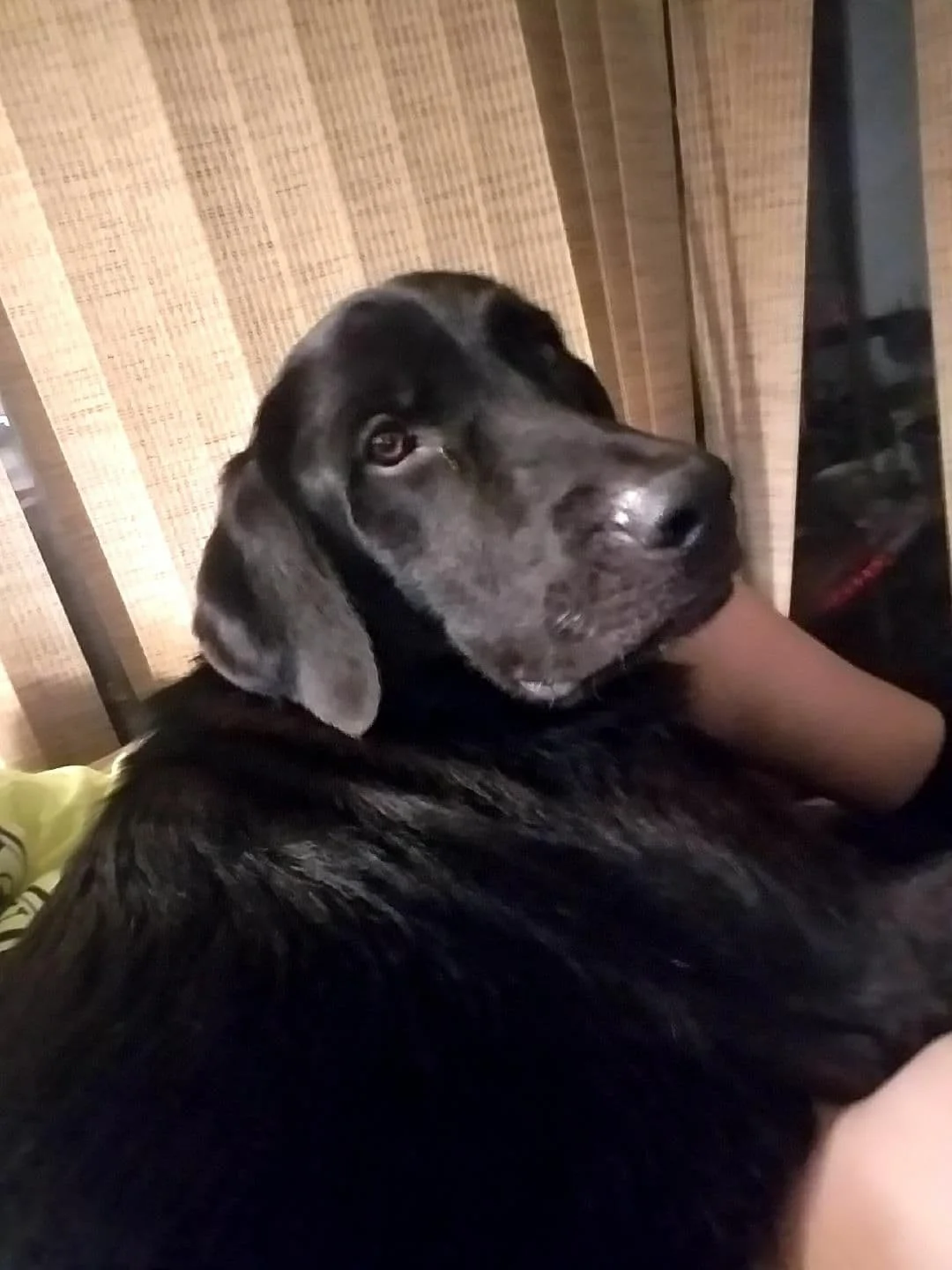
Meet our pet of the month, Orion. Orion is a happy and playful three year old Labrador Retriever who was brought to us due to his inability to get up or walk. Upon closer examination it was discovered that Orion was also experiencing hyper salivation and muscle tremors. Through lab work, a detailed history from Orion’s owner, and physical exam, we were able to determine that Orion was most likely experiencing organphosphate poisoning. Orion’s owner had treated his yard with a commonly used pesticide, unaware that pesticides containing organphosphates can be harmful to pets and people if enough of the chemical gets absorbed through the skin and/or ingested. With Orion’s owners’ permission, we began treating him or the toxicity which involves hospitalization with I.V. fluids, close monitoring for seizures, respiratory distress, and irregular heart rhythm, as well as treatement with injectable Atropine, muscle relaxers, and anticonvulsant medications. After 24 hours of treatment Orion was drastically improved and was released to go home with about a week’s worth of muscle relaxers. We checked on Orion the following day after being discharged and he was completely back to normal and is back to living his happy life with his loving family.
Dottie Krauter
Dottie is a tortoise who was admitted to our office when her owners saw she wasn't feeling well. She wasn't eating and was open mouth breathing. This is not normal behavior for a tortoise as they typically breathe with their mouths closed. Open mouth breathing was a sign that Dottie was having trouble getting enough oxygen in her lungs. Dottie's mom was very concerned and agreed with Dr. Reese that radiographs were in order. The radiographs showed definite signs of pneumonia. But what caused it? After taking a culture and sending it to a lab, we found that Dottie had developed and infection. A regimen of breathing treatments and oral antibiotics was started immediately. Just one problem though, Dottie was not wanting to eat at all. It was very important that we get Dottie to ear, so a feeding tube was surgically inserted into Dottie's stomach. The surgery was difficult, but with the help of his highly trained technicians, it was a success. An incision was made in the side of the esophagus and the tube is inserted down the esophagus into the stomach and was sutured into place so it could not be moved. Now Dottie would be fed from a syringe straight into her stomach until her strength and appetite returned. It was a difficult task, but Dottie's parents never gave up. They did an excellent job making sure Dottie got her breathing treatments and medications. Dottie's feeding tube was finally removed when she started eating on her own and feeling better at home. Today, Dottie has grown and is doing very well thanks to the help of Dr. Reese and his staff. If you have any questions about your exotic pet, please give us a call at Whitehouse Veterinary Hospital so we can help keep your pet happy and healthy!
Scooter Graham
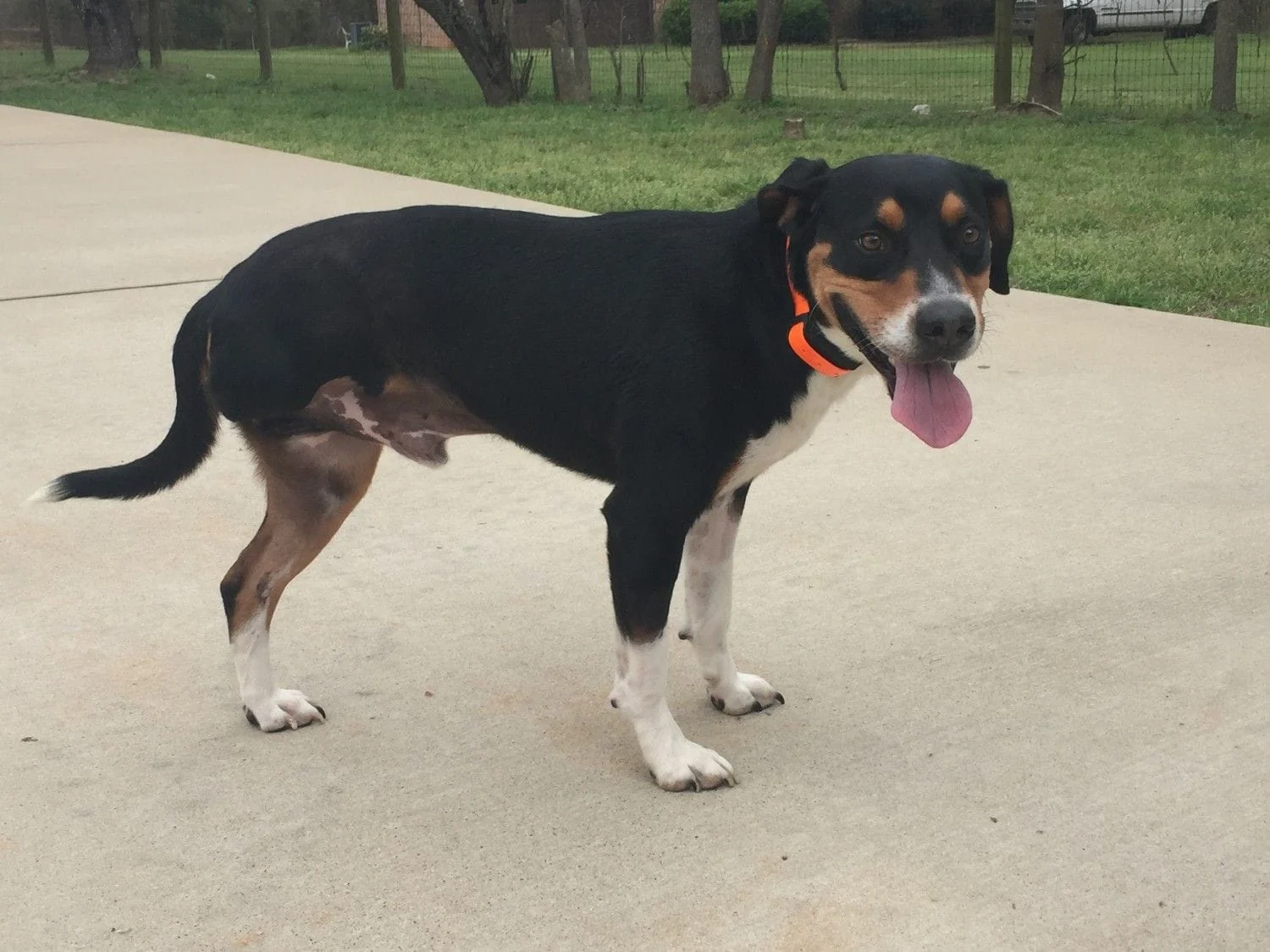
Meet Scooter Graham! Scooter was rushed to Whitehouse Veterinary Hospital after being hit by a car. The Whitehouse Veterinary staff quickly assessed the situation, noting that he had a broken ankle, a swollen femur, several abrasions and a deep laceration. In order to properly treat him, he needed to have radiographs to determine the extent of the damage, but first needed to be stabilized and monitored. Shock treatment was administered and after he was stabilized, the radiographs were taken. The radiographs confirmed pelvic fractures on top of the broken ankle. He would need surgery to clean up the road rash and fix the laceration. The pelvic fractures weren’t too severe and would mend with plenty of rest but the bones in the ankle were severely displaced and surgery would be needed in the future. That evening, however, one of our technicians noticed a swelling in Scooter’s abdominal area and notified Dr. Reese. There was concern that there might be a tear in the urethra and a long-term urinary catheter was placed. This was to keep the bladder empty so the urethra could heal. After several days of hospitalization we were better able to assess the injured ankle. After much consideration, and given the extent of the injury, it was decided that it would be in Scooters best interest to amputate the limb. Even with surgery the bones would fuse and he would not be able to walk properly. However, with the urethra being a potentially life threatening injury, the amputation would need to wait. A splint was applied to the injured ankle to keep it stable until surgery could be performed. Scooter although injured, was still very spirited and energetic making home care an issue for his family. Dr. Reese and the Grahams decided to have him hospitalized so our doctors and technicians could supervise his recovery. It took time for the urethra to fully heal and several weeks later we could start talking about amputation. The long term catheter was removed and Scooter did very well urinating on his own with no sign of swelling. Confident the urethra was healed Dr. Redding removed Scooters rear leg. After a few weeks of recovery Scooter was running around like nothing had ever happened. The Graham family did a fantastic job during Scooters recovery, and had a lot to do with how well he is doing now. Through it all Scooter never complained or lost his happy puppy demeanor. All of us here at Whitehouse Veterinary Hospital are so happy to know Scooter is home with his loving family, happy and healthy.
Bunny Chavis

Bunny is a very sweet four year old pet rabbit, who presented to Whitehouse Veterinary Hospital with a previously broken leg. Prior to coming to us a splint was attempted on the leg with hopes that it would heal. The attempt to heal the fracture by means of the splint was unsuccessful and Bunny had actually begun to self-mutilate the limb which most likely had nerve damage causing Bunny to have no feeling in the limb. When Bunny came to us for her initial consultation with Dr. Reese, the bones if the lower part of the front leg were severely damaged beyond surgical repair and there was a lack of healthy tissue and skin on the lower leg to make a surgical repair of the leg successful. After assessing the injury Dr. Reese discussed the limited options we had that would give Bunny good quality of life and prevent this injury and infected tissue from becoming potentially life threatening. The decision was ultimately made to amputate the leg. Dr. Reese and the Whitehouse Veterinary staff took Bunny to surgery and while the staff closely monitored anesthesia, Dr. Reese was able to successfully perform the amputation of the front leg. Bunny was sent home with pain medicine, antibiotics, and instructions for the owners to follow including complications to watch for. We are happy to announce that Bunny healed nicely from surgery and has made a full recovery! Bunny is now enjoying life at home with his loving and devoted family and should continue to have good quality of life for many years to come.
Oakley and the Fish Hook
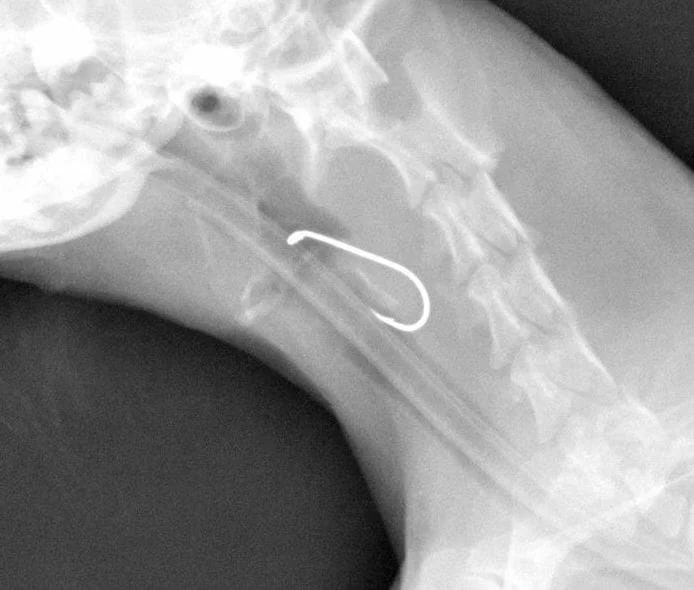
Oakley visited Lake Tyler while on vacation with his family. While out fishing, Oakley found a piece of cheese that was being used for bait attached to a fish hook. Seizing the opportunity for a tasty snack, Oakley swallowed the cheese, along with the hook and fishing line still attached. Oakley’s family immediately brought him to see us as an emergency walk in late on a Friday afternoon and upon arrival was triaged correctly by the reception staff and immediately brought to an exam room to be examined by Dr. Redding. Dr. Redding quickly assessed the situation and sedated her patient so that radiographs could be safely taken to determine the exact location that the hook was lodged. The radiographs showed that the fishhook was in the esophagus and could not be reached from the mouth. Oakley would need emergency surgery to remove the fishhook.
The Whitehouse Veterinary technicians wasted no time prepping Oakley for surgical removal of the fishhook. Once in surgery, Dr. Redding made a small incision into the esophagus at the exact location of the lodged fishhook, while being very careful to avoid the large blood vessels and the arteries that intertwine the tissues in this area. Once the incision was made, the fishhook could be visualized and had actually punctured through the esophagus from the inside out. Dr. Redding carefully manipulated the hook to expose the barbed end which was then cut off so the fish hook could be safely removed through the small incision without damaging any of the surrounding tissue. Once the hook was removed, Dr. Redding sutured her incision closed, making sure a good seal was formed on the small opening into the esophagus. Oakley spent the night in the hospital under careful observation and was discharged the next morning with some pain medicine, antibiotics, and instructions to feed soft canned food for a few days. Oakley followed up with his regular vet in his hometown and has recovered well from his surgery. Thanks to Oakley’s dad, Dr. Redding the Whitehouse Veterinary staff, Oakley avoided a potentially serious and tragic outcome from his date with a fish hook. Oakley quickly returned to his normal happy self and is enjoying life with his loving family.
Pet of the Month
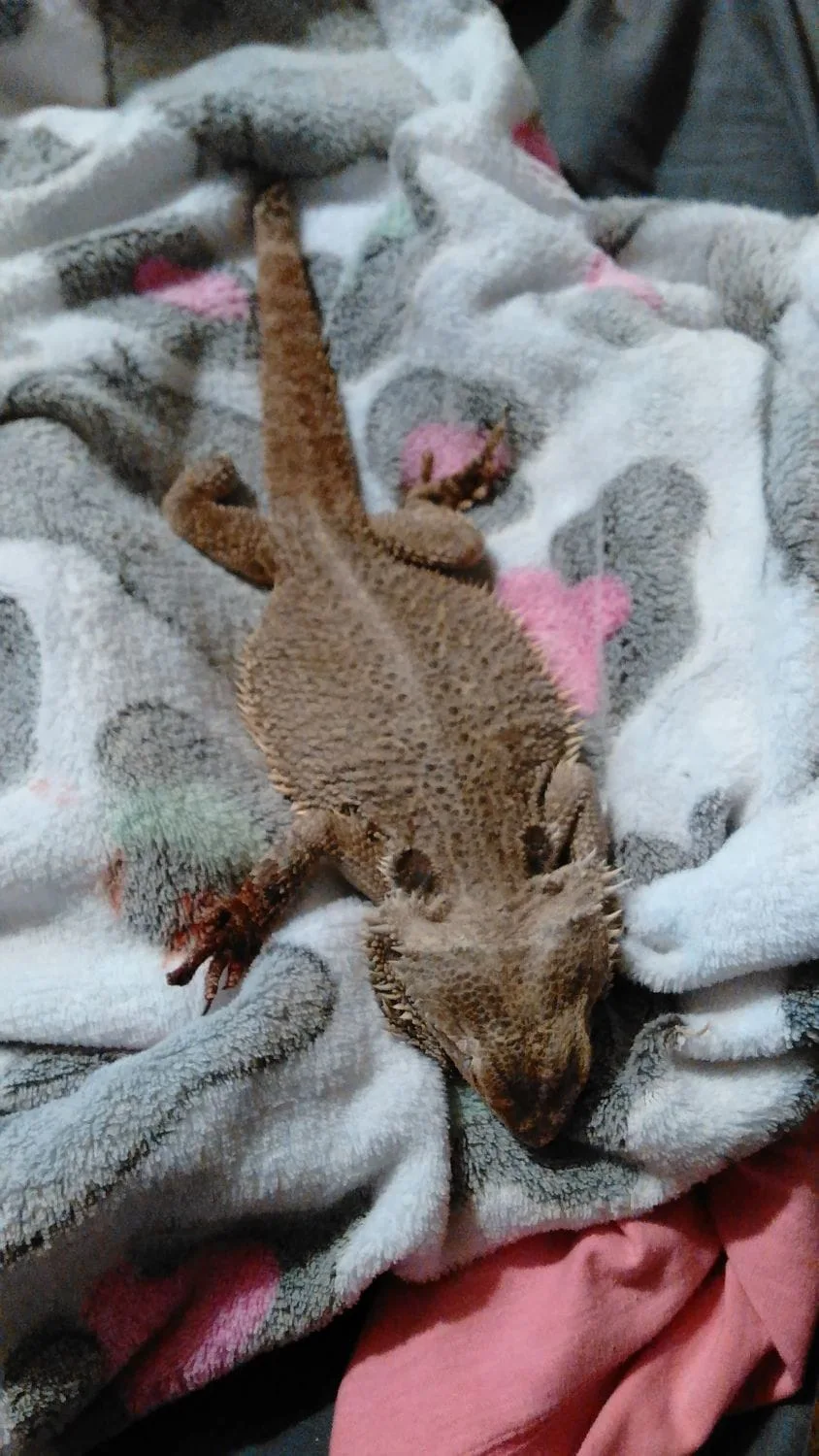
Meet Spartacus, the tough as nails bearded dragon, who first came to us February 2016 in bad shape. He had been rescued from poor conditions that left him extremely underweight, missing a hind foot, part of his tail and with the possibility that one of his front feet would be lost as well. He was a small kid and had been placed inside a terrarium with a much bigger bearded dragon that had not only been keeping him from eating well, but had been viciously beating up on him, causing him to lose his foot. Spartacus was a very lucky guy to have found a new family that was ready to do everything they had to in order to get him back in shape.
Once Dr. Reese examined Spartacus he determined that radiographs would need to be taken, as one of his front feet was very infected and the leg was possibly broken. Sure enough, a fracture was found and Spartacus had to have a splint applied to help him heal. Spartacus received some antibiotic injections and the new owners, the Dickens, were carefully instructed on how to care for him at home while he healed. There wasn’t much else to do at the time, as he was in a delicate state. After the first two weeks, where the owners were very careful in syringe feeding him a blended diet and giving him antibiotics he came back to us a little stronger and had put on some weight. Dr. Reese decided that he needed to keep the splint on a little longer and issued him some more medicine and further instructions for at home care. After another visit two weeks later, Spartacus was doing even better and starting to show more life at home and attempting to eat on his own. The splint was removed and after examining Spartacus, Dr. Reese said the leg needed more time to heal but the foot was still questionable. There was a very real possibility that it might not be able to be saved after being mutilated so badly. The Dickens’ were determined to do all they needed to, as Spartacus was fighting to get better. They made sure he had the best care possible and learned how to perform hydrotherapy on his foot to try and increase blood flow to the area to try and revitalize the tissue. One more exam two weeks later and the foot was improved! It was looking much better but at that stage it would never be completely normal. Spartacus didn’t care though and is now living life to the fullest with his loving family!
Pet of the Month
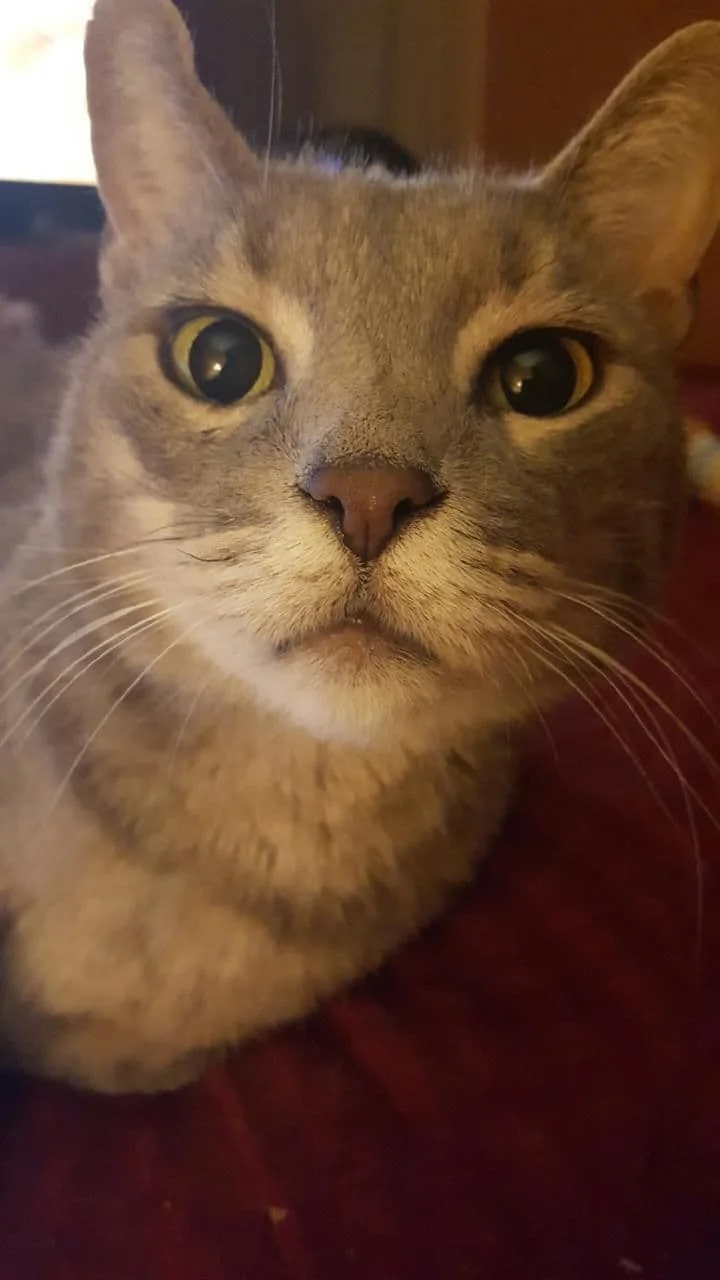
Vern was a very sick kitty that came to us in July. He was found wandering around a barn, very thin, no tags and no collar. Despite being in this homeless situation, Vern was very sweet and had a lot of love to give.Once at the hospital we ran some tests on Vern and found out that he is FIV positive. This is not a death sentence but it is very serious, FIV is a blood disease in cats that affects their immune system. Much like AIDS in humans, FIV is usually contracted through deep bite wounds after fighting with another infected cat, but it can also be passed down from the mother.
During his road to recovery, Vern kept having days where he was not eating, and not acting his lovable self. After performing blood work,we discovered that not only was he infected with FIV but he had an additional 3other types of blood diseases caused by parasites. Luckily for Vern these 3diseases could be controlled and cured with medication and monthly visits to the hospital. Vern now lives with our wonderful groomer Amanda and her baby, Spicoli. Vern is happier than ever, enjoys extra affection, and the food his owner loves to share. Amanda says that he is such a character and has a huge personality. We are all very thankful and happy that we were able to help Vern and give him the second chance he was fighting for.
Pet of the Month
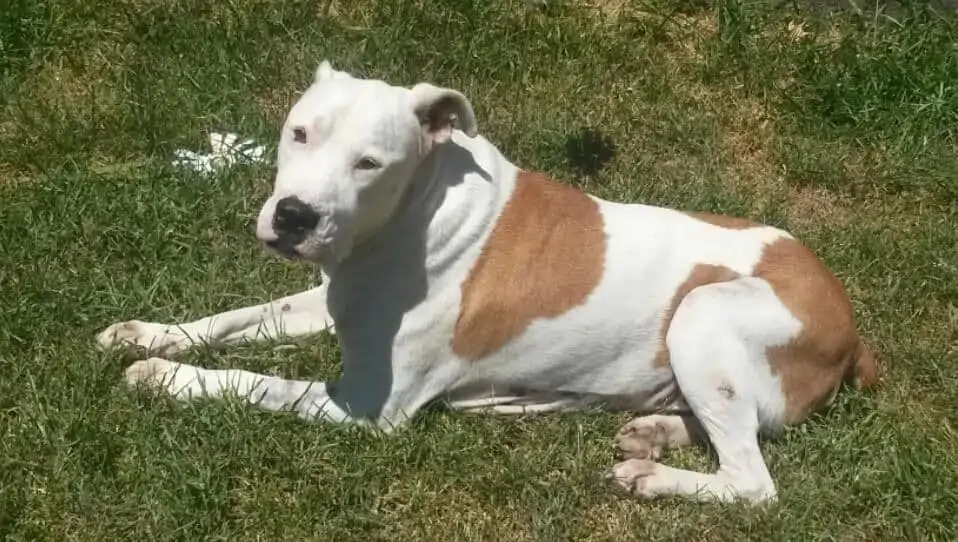
Duke is an awesome, fun loving American Bulldog who belongs to our very own Stacia. One evening, his owners woke to Duke collapsing on the floor of their kitchen and shortly after he started having seizures. After staying up with him the few hours until morning, she brought him in to get be seen by Dr. Reese. On the physical exam Dr. Reese thought he felt something unusual in Dukes abdomen and recommended blood work which gave abnormal results. The next step was to confirm what was felt on the exam and thanks to our new ultrasound capabilities, Dr. Reese was able to find and diagnose a mass on Dukes spleen.The next course of action was surgery to remove the mass. After a very painstaking surgery Dukes entire spleen had to be removed in order to remove two large masses inside of it. Duke did very well in recovery, and soon was feeling much better. He slowly began to eat and wanted to walk around outside.The mass was sent off to a lab and unfortunately it was found to be cancerous. He was given medication to make him more comfortable at home and he gets to be at home with his family a little while longer and is feeling much better and loving life. It’s the little things that make us love our furry family members so much, so the next time your little furry friend isn’t feeling well, give us a call. Dr. Reese and his friendly staff are always here to help keep your pet happy and healthy.
Pet of the Month

Lilly is a 19 month old Marmoset who lives with her family, the Hancocks’! In March 2015 Lilly came to us not feeling well, not eating well for her parents at home or acting her normal self. Being as small as she was, Dr. Reese recommended some testing to determine the cause of Lilly’s issues.
We performed a Barium study on Lilly, which is where we have the patient swallow a liquid that will show up on the radiographs and help us determine if there is a blockage. Images must be taken every few hours so we can follow its progress. After 6 hours, the barium had not moved from its location in the intestine. After administering some injections, we sent Lilly home with additional medicines to help loosen her stool and see if we could get rid of the blockage. In the days that followed, Lilly made a wonderful turn around. She began eating better at home,drinking more on her own and had started having regular bowel movements. During her follow up we performed another x-ray and found the barium had finally moved through all of her intestines and no blockage or foreign body was seen. We could finally give Lilly a clean bill of health. Now she rests at home, loved by her family and spoiled rotten! We’re glad you’re feeling so much better Lilly!
Pet of the Month

Meet our brave pet of the month Buster Luke! Buster Luke is a sweet black lab that came to us not feeling well at all. He had been vomiting and having irregular bowel movements. After careful examination, Dr. Reese believed he had palpated something in Buster’s abdomen. With Dr. Reese’s recommendation, Buster’s parents gladly agreed that radiographs were in order.It was immediately apparent that Buster had swallowed three very large stones,about the size of golf balls. It was obvious that the stones had no intention of passing all on their own, and with Busters health already declining,immediate surgery was recommended. Without a second thought Buster’s parents agreed to the surgery.
Once under anesthesia, Dr. Reese was able to make his incision in the abdominal area to expose the intestines. There he had to manually palpate the intestines to find the exact location of the stones. After careful and tedious searching, two stones were located in the intestines with one left in the stomach. An incision was made in the intestine to remove the two stones one of which was stuck to the intestinal wall, causing a great amount of irritation. After closing the first incision another was made in the stomach to remove the final stone. With help from his skilled technicians who constantly monitored Buster’s vitals and assisted in the surgery itself, all three stones were successfully removed. Buster made a brilliant recovery and is now happy to be at home with his family who love him dearly. Our pets mean a great deal to us all and we at Whitehouse Veterinary Hospital are proud to help keep your pet happy and healthy.
Pet of the Month
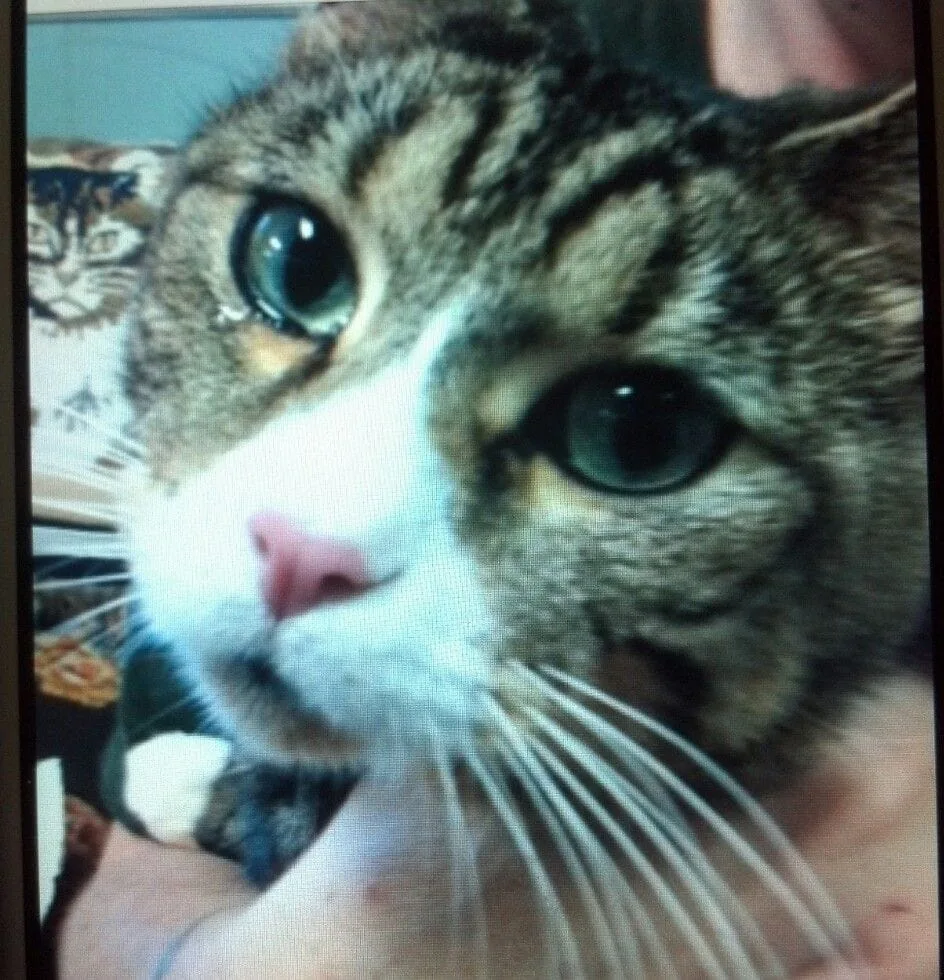
Goon Shirey is a 5 year old tabby cat that came to us this past August with urinary issues. His owner noticed that he had not urinated in about 1 – 2 days and was concerned, which is rightly so since a feline with a urinary obstruction can be a life threatening situation. Upon examination, Dr.Reese did in fact find that Goon was obstructed. As stated before, this can become life threatening, so to treat him semi-aggressively he was anesthetized and a urinary catheter was placed. Dr.Reese then retropulsed the crystals causing the blockage, which means that the crystals were flushed back into the bladder so that Goon could urinate on his own. He was then hospitalized so we could keep his catheter flushed and given diazepam to help the urinary sphincter relax so Goon could urinate more easily. After a few days he was released and seemed to be doing well at home. Goon was on antibiotics to treat and help avoid any infection and was also prescribed a special diet called C/D which helps lessen or even stop the formation of urinary crystals which were causing Goons blockage. After about a week of doing well, Goons mom noticed some blood left behind when he moved from a spot he was sitting. He came back to see Dr.Reese the following day and was found to be blocked once again. A cystocentisis was performed by Dr. Reese to empty his bladder and it was then decided that a Perinial Urethostomy was going to be the only way to fix Goons problem. This procedure is very tricky and basically means we re-routed his urinary tract. By doing this the urethra is much bigger so that any crystals left in the bladder will pass during normal urination. Goon did very well after surgery and after weeks of checkups and antibiotics and staying on C/D feline urinary food to hinder the formation of more crystals, he is doing great. He is now a happy,healthy kitty and his mom is very grateful for all the care Dr. Reese and his staff here at Whitehouse Veterinary Hospital gave her very sick kitten. So if you notice anything out of the ordinary with your pet, Dr Reese and his friendly staff are always here to give the love and care that you pet deserves.
Pet of the Month
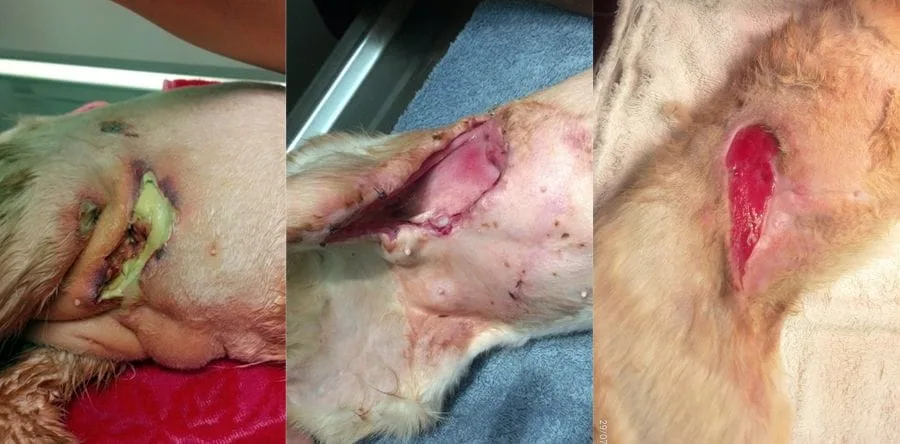
We'd like to introduce a wonderful cat that has surprised us with his stellar attitude and the tremendous amount of patience ha had during treatment here at the hospital. Meet Mr. Kitty Burns, and orange tabby who's a whole lot of awesome. Mr. Kitty first came to us in May with two abscesses, one on his back and another on his side. Dr. Reese recommended that they be lance and flushed so they could begin to heal as well as a culture to be taken and sent to a laboratory called TVMDL to see what kind of bacteria caused the infection.
The surgery went very well and Mr. Kitty was sent home with medication and treatment plan which called for the abscesses to be flushed and treated several times a day. Unfortunately, he did not respond to the medication and flushing as we had hoped and when the culture results came back we found out why. There was a type of bacteria called Actinomyces that is hard to kill and was the cause of his downturn in treatment. This called for a more aggressive plan and the owners opted to hospitalize Mr. Kitty so he could receive proper care.
Mr. Kitty's new plan called for antibiotic injections, a sterile flush of the abscesses, hydrotherapy, oral medication, and topical treatments. The flushing and hydrotherapy allowed the large amount of pus that was building up each day to be washed away and help the infection from spreading further, while the tissue around the wound that was already infected died and sloughed away. Eventually the tissue that died created a large open area about the size of an adult hand, on his side, belly and down his leg. Through his entire stay he allowed us to inject, flush, wipe, and hold him under a faucet and yet complained very little. This was a huge deal because he ended up having to have this done twice a day for nearly two months!
The plan worked and the infection was eventually brought under control and stopped affecting the tissue. To be sure, we sent off another culture and the results confirmed that the infection was finally gone. This allowed him to start healing, which would be a slow process. Dr. Reese consulted an internal medicine specialist who suggested that we use a wrap called Calcium Alginate that would accelerate the healing process. This wrap was changed twice weekly and did wonders for the wound. It got smaller and smaller and then finally fully healed. Thanks for all your patience and trust Mr. Kitty!
Pet of the Month

Our pet of the month is Major Layne, a 14 year-old black lab owned by Mark and Cheryl Layne of Whitehouse. In October, Major had an unfortunate encounter with the tire of a slow-moving vehicle, which crushed part of his tail. When home treatment was unsuccessful, Major was brought in to see our doctors. Major was suffering from nerve damage and infection, which resulted in him chewing off part of the tail.
Due to major inflicting more damage to an already existing injury, he then suffered a 'major' infection by going septic. Dr. Reese performed surgery to remove most of his tail, flushed and debrided the wound. (Debridement is the removal of dead, damaged or infected tissue to improve the healing potential of the remaining tissue.) Dr. Reese put Major on a regimen of broad-spectrum antibiotics and hydrotherapy treatment. Due to Dr. Reese's excellent care, Major is making excellent progress in his recovery.
Pet of the Month

Dakota Lindenmuth is a happy, never-met-a-stranger 10 year-old lab with Lymphoma. He came to see Dr. Reese in February with multiple large swellings (lumps) in various places on his body. Dr. Reese performed a cytology on several of the lumps to determine the cause. A cytology is where a needle is inserted into the mass and cells are sucked out and placed on a slide, which is then stained and looked at under a microscope. Dr. Reese found lymphosarcoma cells in the sample. We then sent the slides for confurmation to Texas A&M. After tets, they send back a diagnosis - it was lymphosarcoma. Dr. Reese then called an Oncologist and sidcussed treatment protocol.
Dakota has spent the last 21 weeks going through treatment - 4 weeks of three different Chemotherapy drugs and then 1 week off to rest. During the entire treatment Dakota has been a joy to have as a patient, always happy to see us with a wagging tail and a doggy grin. Dakota will have to return to see Dr. Reese for regular rechecks to monitor his health and to make sure we keep his lympho sarcoma under control. We're sure he'll continue to be a joy to have and be the trooper he has always been.
Pet of the Month
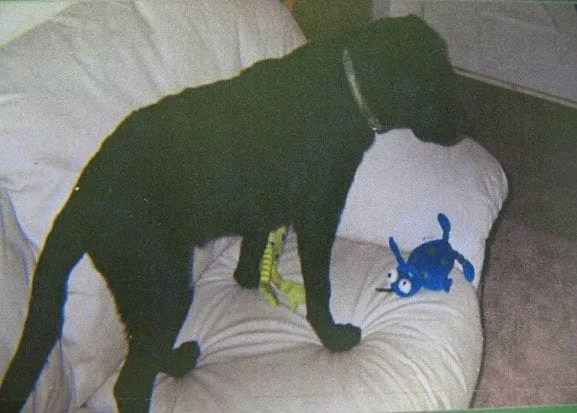
Remington Wyatt is a beautiful black lab mix puppy that was lucky to be found, along with her brother Ruger, by Haley Wyatt. Haley was not prepared for what was about to be discovered. Remington appeared to be a perfectly healthy puppy from the outside, until her examination. A severe heart murmer was discovered. Remington was referred to Shelley Drive Animal Hospital of Tyler for an echocardiogram. The echo revealed suspected subaortic stenosis. She was referred down to Texas A&M University to the Medical Teaching Hospital. Once at A&M, radiographs, doppler and another echocardiogram were performed. After these tests, Remington was diagnosed with PDA, or Patent Ductus Arteriosus. PDA is a congenital heart defect that is present at birth in which an abnormal circulation of the blood between two major arteries near the heart occurs. Without surgery, PDA can be fatal. Haley was faced with a decision which could change Remington's life. Being the passionate person that she is of course she opted for surgery! Remington was scheduled soon after and the surgery was a success. He has since recovered and is a very happy and healthy puppy!
Pet of the Month
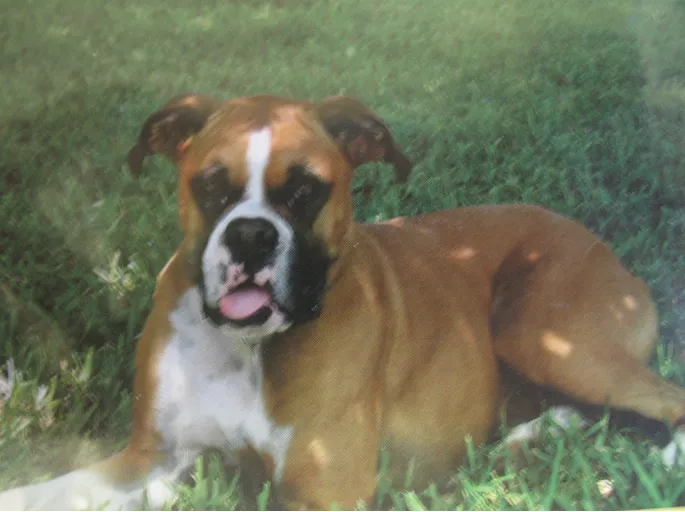
Maggie Tees is a 10 year-old female Boxer who lives in Arp, Texas with her owner, Mr. Al Tees. Maggie loves to play with her running mate, a chocolate Lab called Jayne. Mr. Tees brought Maggie into our office after noticing that she was eating healthy amounts of food, but losing weight. We began with blood work and x-rays and discovered a mass (growth) in the abdomen. To study the mass further, Maggie was taken to Shelley Drive Animal Clinic, where an ultra-sound was performed. A suspicious mass was noted during the ultra-sound exam. Dr Reese performed exploratory surgery and found that mass near the end of her stomach. A surgical biopsy was take which diagnosed Maggie with a muscular tumor of the stomach. Maggie was then referred to a Veterinary Surgery Specialist in Dallas in an attempt to remove the tumor. During surgery it was determined that the tumor could not be safely removed. Due to Maggie's age and health the doctors decided that it would be best not to pursue treatment. The specialist felt that she could lead a good life with a diet catered to her specific needs. Now she eats all she wants of a high protein, fatty diet and is gaining weight again and doing well.
Pet of the Month
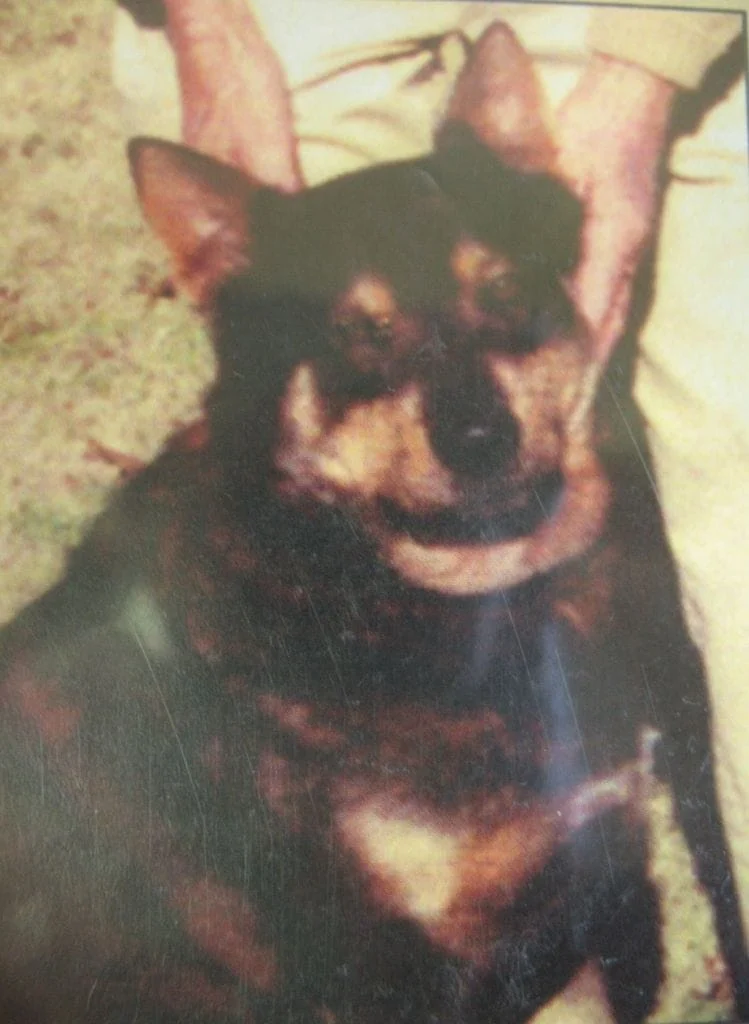
Bud Bybee is a loving 13 year-old mixed breed that suffers from Atrial Tachycardia and congestive heard failure. What that means is that he has a premature beat of the atrium. Dr. Reese diagnosed Bud by running a diagnostic EGK, blood pressure, chest radiographs (x-ray), along with blood work. When reading the EKG, he noticed abnormal "P" and "R" waves, and that the heart rate was increased. On the chest radiographs, the heart was rounded with pulmonary congestion. After discussing the case with a Cardiologist, Bud was put on 3 different heart medications to help control the rate of his heartbeat, help his heart beat stronger and to treat his congestive heart failure.
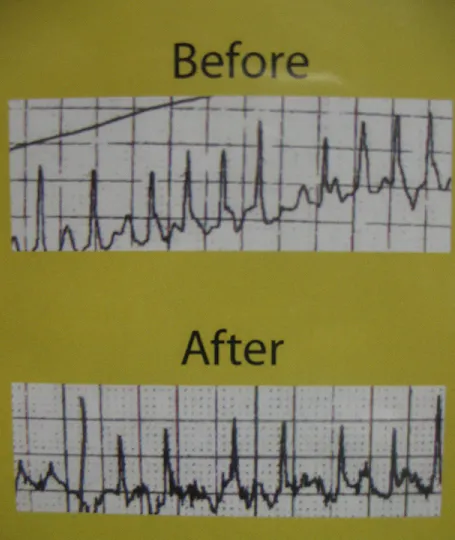
After many re-check exams, more blood work and EKG's, Bud's heart rate and congestive heart failure seemed to be under control.
Pet of the Month
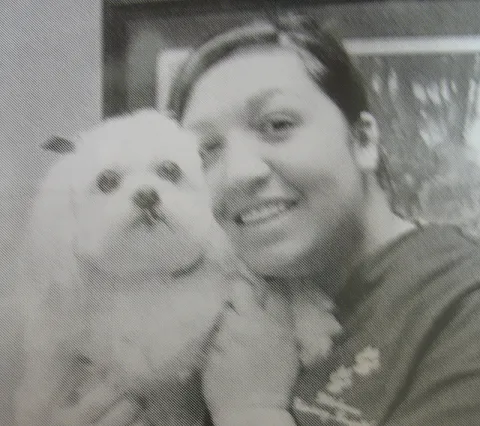
Baby Girl (Stinky) is a 10 year-old Maltese mix who has been a long time patient here at Whitehouse Veterinary Hospital. In February 2007 she came in for her semi annual check up that we recommend for every patient During this visit Dr. Reese discovered that she had a low-grade heart murmur. It was not severe enough to warrant immediate medical attention, but regular monitoring was needed.
In late November Stinky came in coughing and was diagnosed with tracheobronchitis and early stages of pneumonia. We did a series of nebulizing treatments and send her home with antibiotics and steroids. We had a follow up appointment where Dr. Reese also discovered that Stinky was also in congestive heart failure or CHF. CHF is failure of the heart to advance blood at a sufficient rate to meet the metabolic needs of the patient or to prevent blood from pooling within the pulmonary venous circulation. We will continue to monitor this condistion until it worsens. At that point Stinky will be placed on a diuretic and a blood pressure prescription. This will help Stinky live a longer, happier life. CHF is not a curable condition, however with proper monitoring and treatment, canines with CHF can live a high quality of life for several years.
Pet of the Month
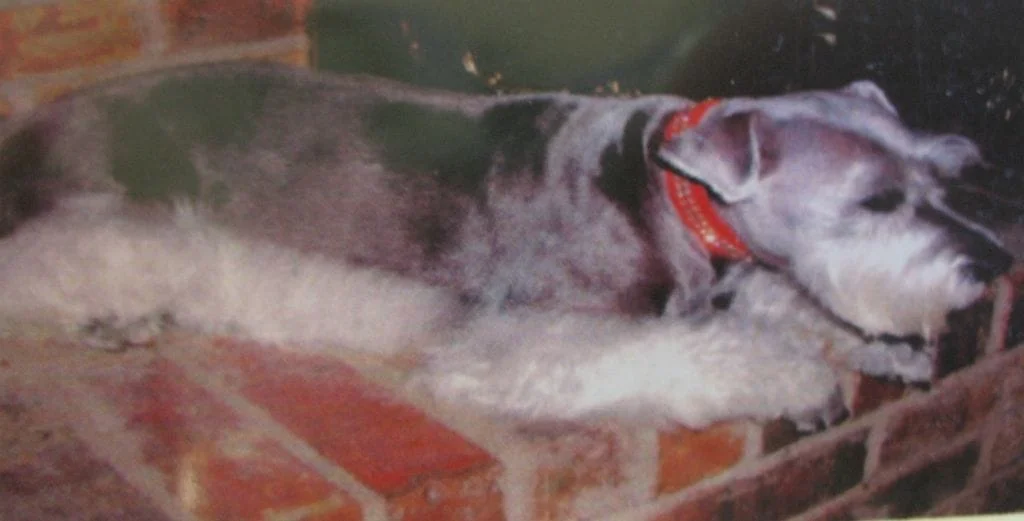
Chelsea is a 7 year-old Miniature Schnauzer who is owned and cared for by Joyce Stanley. Chelsea was diagnosed with diabetes in August of this year. Diabetes Mellitus (DM) is a chronic condition in which a deficiency of the hormone insulin, which impairs the body's ability to metabolize sugar. It is one of the most common endocrine (hormonal) diseases of dogs. Risk factors for diabetes Mellitus include obesity, recurring pancreatitus, and Cushing's disease. Mrs. Stanley is currently treating Chelsea with insulin injections daily to control her diabetes. Chelsea has to be brought to us on a regular basis for a diagnostic test called a glucose curve, which helps ensure that her diabetes is well controlled. In addition to the diabetes, Chelsea also has hyperadrenocorticism, or Cushing's syndrome. This refers to a disease state in which an overactive adrenal tissue produces excessive amounts of cortisone. Cortisone and related substances are essential hormones of the body, but when produced in excessive amounts may cause systemic illness. Mrs. Stanley treats Chelsea with a medicine called Lysodren, which is administered once a week to help control this disease. So with proper care and management, Mrs. Stanley and Chelsea will have many more happy years together.
Common early signs of endocrine disease include drinking more water, urinating more, loss of appetite, and a potbelly appearance. If you happen to notice any of these in your pet, we recommend having your pet checked. Simple blood tests can diagnose most endocrine system diseases.
Pet of the Month

Cinnamon Corbitt is a 9 year-old blonde Cocker Spaniel who belongs to Mr. and Mrs. Corbitt of Tyler, Texas. Cinnamon has been coming to visit us for years. She was diagnosed with Hyperadrenocorticism (HAC), commonly known as Cushing's Disease, in 2002. HAC is a disorder caused by excessive production of cortisol by the adrenal glands. Some common symptoms can include increased amount of water intake, urinating frequently, thin skin and black heads on the stomach region. Cinnamon takes a daily prescription known as Anipryl and has regular check ups and blood work known as a Low-dose Dexamethasone Suppression Test done. Cinnamon has been living with HAC for 5 years now and is doing fine.
Pet of the Month
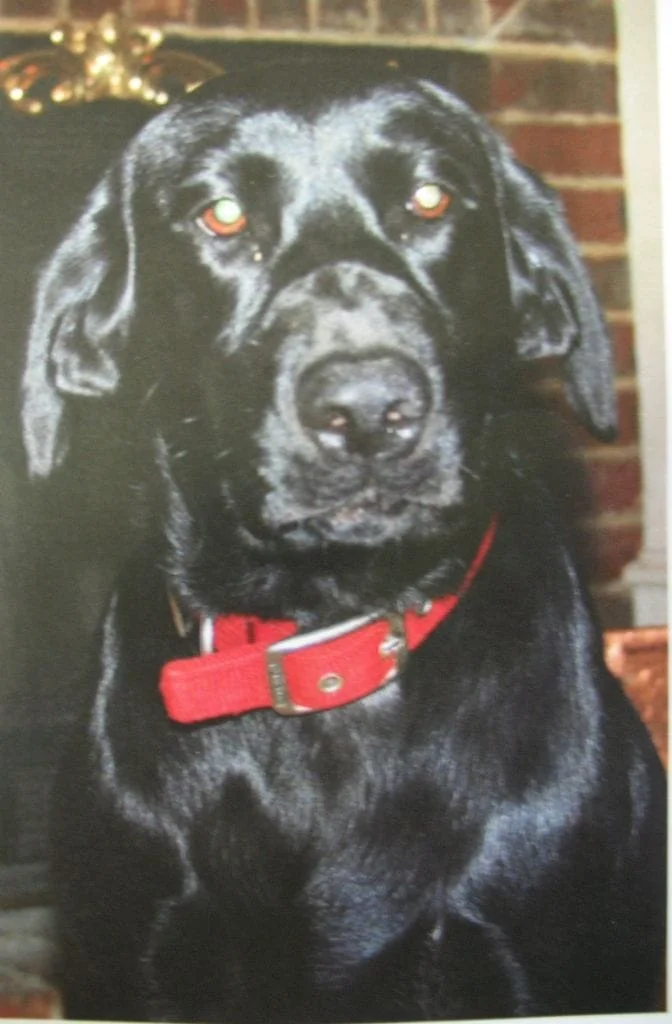
Georgia Cartwright is a 15 month-old black lab that came to us in April presenting symptoms of vomiting, anorexia, lethargy, and dehydration. These symptoms could easily be mistaken for several diseases such as liver or renal disease or possibly even pancreatitis. With blood work and x-rays these assessments were ruled out. Georgia was already past the age that we normally see the virus known as parvo but we wanted to make sure we could completely rule it out by doing a parvo test. Unfortunately, the parvo test came back positive. Georgia was hospitalized and given IV fluids and several injections to treat the symptoms of parvovirus. She was also given a plasma transfusion. Plasma transfusions supply a parvo-infected with virus fighting antibodies. This can be a very beneficial part of canine parvovirus treatment. The above treatments allowed Georgia to make a full recovery. Canine parvovirus is very serious and can lead to death if untreated. Getting a series of vaccinations for your puppy can prevent this. Georgia is doing very well and we hope to care for her for years to come.
Pet of the Month
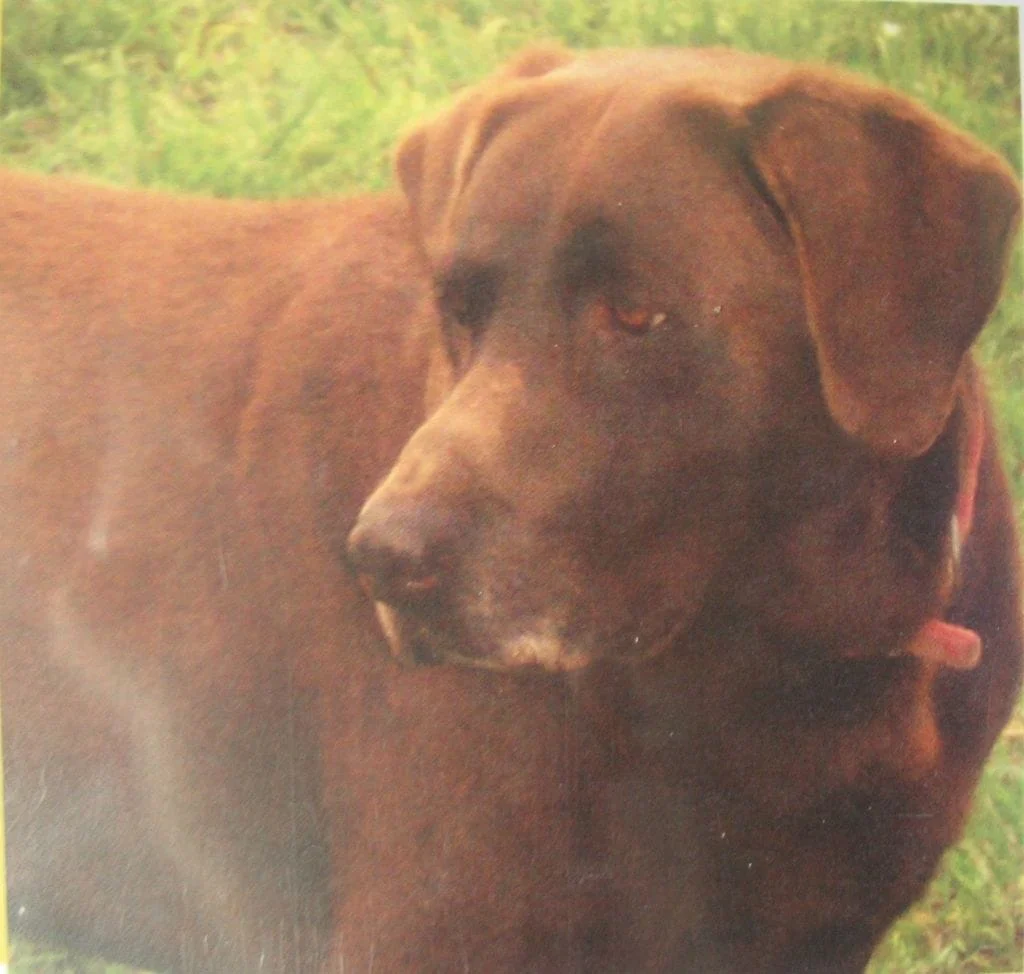
Koko McGuire Obannon was presented to our hospital back in December of 2006 with vomiting and lethargy that had been going on for two days. During Koko's exam, Dr. Reese noticed that he was very tender on the abdominal palpation. After running blood work and other tests we found that Koko had pancreatitis. We hospitalized him and and he was kept on IV fluids and several medications. After not seeing much improvement over a few days we decided to perform a barium series. A barium series is where a thick fluid is ingested that can be seen on an x-ray. Several minutes after ingestion, a series pf radiographs is started, which are taken every 2 hours for a 4-6 hour period depending on the speed of the barium movement. If the barium stops without passing through, then mostly likely there is a blockage of the intestines or stomach. We noticed on Koko's radiographs that the barium had stopped in his small intestines.
We then emailed the films to Dr. Robert Barstad of the Dallas Surgical Center for review. After reviewing the x-rays, he recommended that Dr. Reese perform an exploratory surgery. And exploratory surgery is where Dr. Reese surgically opens the abdominal area and explores that abdominal cavity for any abnormalities. Luckily for Koko, we were able to find what had caused the blockage. There was an object lodged in his small intestine and after making a surgical incision Dr. Reese discovered that the culprit was a Christmas sock that he had swallowed. Dr. Reese removed the sock and closed the incision. He was put on a regimen of antibiotics, pain medication and an intestinal diet called I/D for several weeks until he healed. He is doing very well and glad to be back home.
Pet of the Month

Chubby is an active 10 year old German Short-hair Pointer owned by Mike and Lisa Craig. Chubby is a hunting dog and still hunts even though he occasionally suffers from arthritis. When needed his owners medicate him with Rimadyl to help with the pain and stiffness. Athriitis is a degenerative joint disease that is progressive and causes permanent deterioration of cartilage and joints due to primary and secondary causes. Some of the signs to look for are a decrease in activity, lameness, stiff gait and joint trauma. Chubby is ready to go this year, he has had his rattlesnake vaccination and a check up by Dr. Reese who has declared him ready to hunt. Though, he might have to retire soon; Mrs. Craig reports that he is becoming hard of hearing.
If you notice and of the above signs in your own pet, please see us at Whitehouse Veterinary Hospital. There are plenty of products on the market such as Rimadyl and J/D diet to help make your pet more comfortable. Another supplement for arthritis, especially in the colder weather, is glucosamine, which you can pick up at your local pharmacy. Contact our office for a dosage.
Chubby has been a patient of ours for as long as we can remember and we look forward to caring for him for years to come. When he retires, Chubby will spend the rest of his life playing with the other short-haired members of the Craig residence.
Success Story of the Month

Midge is a 150lb, 31 year-old Chimpanzee who resides at the Cleveland Amory Black Beauty Ranch with many other exotic friends. Midge came to us in late 2006 after an accident that resulted in a fracture of his right fibula and tibia. The only way this fracture would be able to heal properly was if he were to undergo surgery. On the day of the surgery Dr. Reese had two orthopedic specialists from Texas A&M University come in. They used two stainless steel surgical plates on the tibia to bring the bone together. Several surgical grade stainless steel screws were used to keep these in place.
The surgery itself took nearly two and a half hours and at the end the doctors were all pleased with the results. Afterwards, after being taken back home, Midge was kept in a small unit to keep him from moving too much and re-injuring himself. The staff at Black Beauty helped him with his rehabilitation and over the course of a month and a half he was gradually allowed to move more freely. Soon he was allowed back into his regular enclosure with his two female companions and was ready to play. Midge is doing well today and living life to the fullest!
Pet of the Month

Mini Me is not your typical pet of the month. She is a sweet 3 year-old ferret owned by Susann and Gene Helgesen of Whitehouse and has a brother ferret named Curi-o. Mini Me came to us a couple of months ago with vomiting and no interest in food. During the beginning of her symptoms, conservative treatment was done for gastric ulcers, which are common in ferrets. After a few weeks on medications with no improvement, blood work and x-rays were performed but still not revealing a diagnosis. For a few weeks Mini Me seemed to make a turnaround and was making improvement, however, at the end of April she had a setback. Dr. Reese determined that a procedure called a barium series would be necessary. Barium is a thick fluid that is ingested and after several minutes a series of x-rays are taken. If the Barium stops without passing through, then mostly likely there is a blockage in the intestines or stomach. After several hours the Barium was very slow to leave the stomach and the bottom of the stomach seemed abnormally enlarged. With this information in hand, Dr. Reese decided an exploratory surgery needed to be performed. During surgery a large mass was discovered and was determined to be an extremely large fur ball. Much to the relief of the Helgesens, Mini Me made a full recovery and is doing great today with a wonderful appetite. For the prevention of recurring fur balls, she is on a daily hairball controller and papaya enzyme tablets.
Pet of the Month

Lila Holloway is a 3 year-old longhaired dachshund who belongs to the loving owners of Brenda and Basil Holloway. They have three children; Trey, Katie and Courtney who treat Lila as their own sibling. They have raised Lila since she was six weeks old.
Lila came to us in November of 2005 in a comatose state. She was extremely cold, very shocky and near death. Although at the time Lila?s future seemed bleak, emergency and shock treatment were initiated. Lila?s early lab work showed that she was anemic, had very low clotting capabilities and had severe liver inflammation. Several things could be the cause of the above mentioned lab abnormalities such as poison, some tick borne diseases, and leptospirosis. Initial treatment of IV fluids, corticosteroids, oxygen therapy, antibiotics and warming of Lila started to improve her condition. Symptomatic treatment for rat poisoning, leptospirosis, and immune mediated anemia were also started. After a day or two of treatment Lila was conscious and able to move around but her liver was still inflamed, her anemia had worsened, and her blood would still not clot. Her owners allowed a blood transfusion and a liver biopsy. The blood transfusion immediately improved Lila?s condition. The liver biopsy demonstrated that 60% of her liver had died. As more testing results were known, Lila?s disease was narrowed down to hepatic necrosis most likely secondary to leptospirosis.
Leptospirosis is caused by a spirochete organism, which often causes kidney or liver disease in dogs. It?s often spread by water contaminated with urine and rodents who can also carry the disease. It is not very common here but has been reported to be increasing in numbers. We do vaccinate for most types of leptospirosis her at Whitehouse Veterinary Hospital.
Fortunately, Lila slowly responded to treatment for leptospirosis, her blood clotting regularly and the inflammation in her liver decreasing leading to her full recovery. Lila is the Pet of the Month because she has demonstrated a very will to live against the odds. The other important aspect of her case is that it demonstrates the importance of laboratory testing in unusual cases. Without performing the liver biopsy and tests to rule in or out possible causes of Lila?s disease we would not have been able to treat her successfully.
Pet of the Month
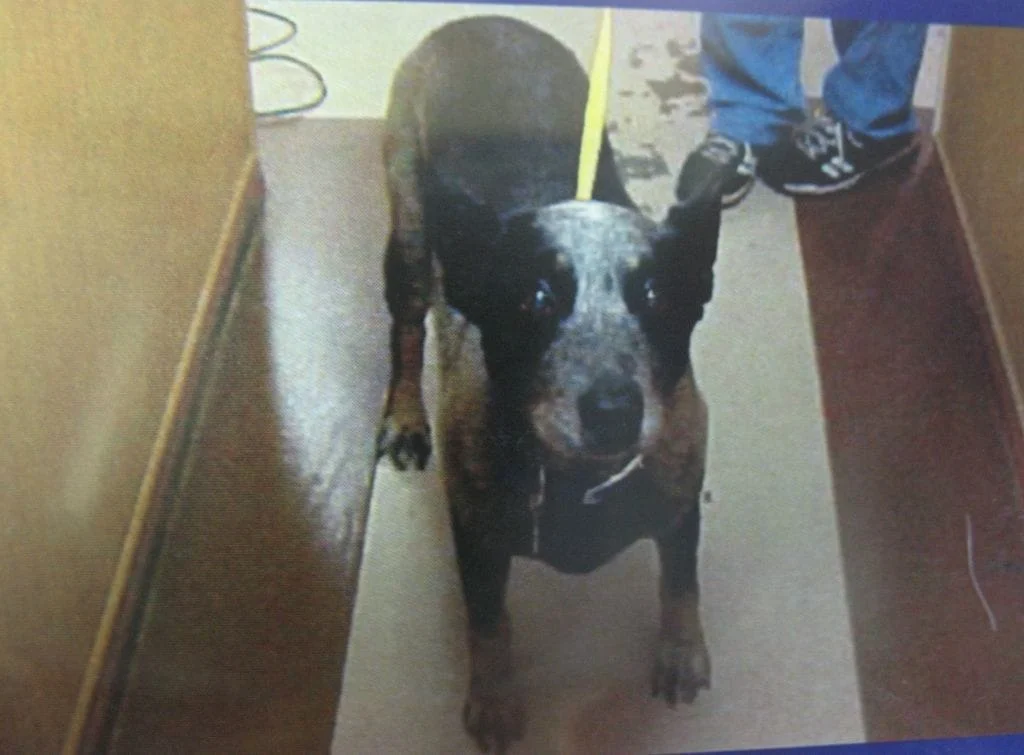
Say hello to Shiner, an 11 year-old Blue Heeler owned by Robert Hiller. Shiner has been a member of the Hillier family since he was a pup had is a canine resident of the Chapel Hill area. He and Mr. Hillier take walks in the park and visit other family members on a regular basis. Shiner is a very intelligent canine. For instance, if Shiner is out of food and/or water, he will go get Mr. Hillier and take him to his bowls. Shiner also has his own unique way of letting Mr. Hillier know when something is bothering him or if he feels wrong. Recently, Shiner was presented to our hospital drinking more than the normal amount of water, losing weight and urinating more frequently. After a complete physical exam and a few diagnostic tests, Dr. Reese concluded that Shiner had become diabetic.
Shiner has what is known as Diabetes Mellitus, a disorder of carbohydrate, fat, and protein metabolism caused by an insulin deficiency of the body. Bodily systems affected include endocrine, metabolic, ophthamolic, and renal (kidney). Thus, with this being said, animals are more likely to lose electrolytes, are at higher risk for cataracts and urinary tract infections. Mr. Hillier is currently treating Shiner with insulin injections two times daily and a prescription diet called canine W/D. Shiner is being brought to our hospital regularly for a diagnostic test called a glucose curve, which helps ensure that Shiner?s diabetes is well controlled. With proper management Shiner and Mr. Hillier will continue to have many happe years together. So if you notice your pet drinking more water, losing weight or even urinating more frequently, you pet may need to visit your vet.
Pet of the Month
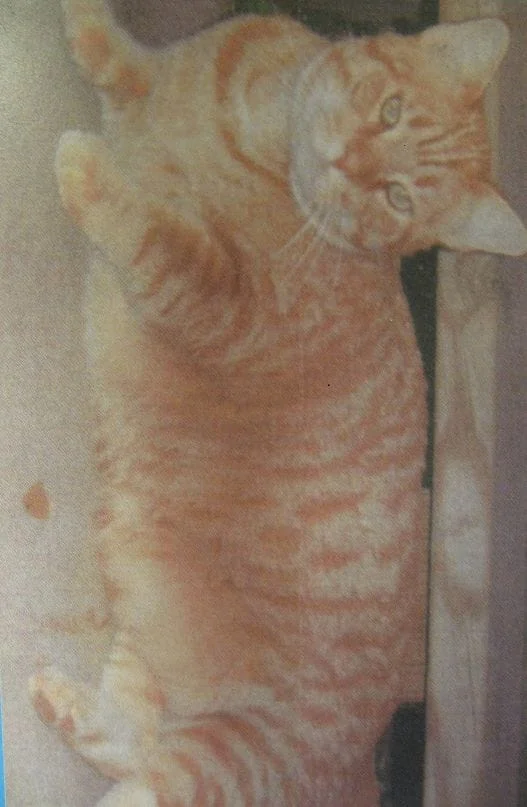
Tiger Hale is a handsome and loving male orange tabby. He lives with Mrs. Hale, who rescued him from living a life on the streets in Troup, Tx. Tiger was diagnosed with FIV (Feline Immunodeficiency Virus) In January of 2004. FIV is a retrovirus that causes an immunodeficiency in cats. FIV is otherwise known as feline AIDS. Tiger takes human recombinant alpha interferon medication to help prolong his life. Because Mrs. Hale has other cats that Tiger can spread FIV to, he lives in the bathroom of the Hale home. Mrs. Hale hopes to have a protected outdoor protected enclosure built for Tiger so he can spend time outside on nice days. Currently, he watches the birds and other wildlife from the window. When his enclosure is complete, he will feel much closer to the outside world. At this time, Tiger is doing great and we hope he continues to do well for years to come.
Pet of the Month
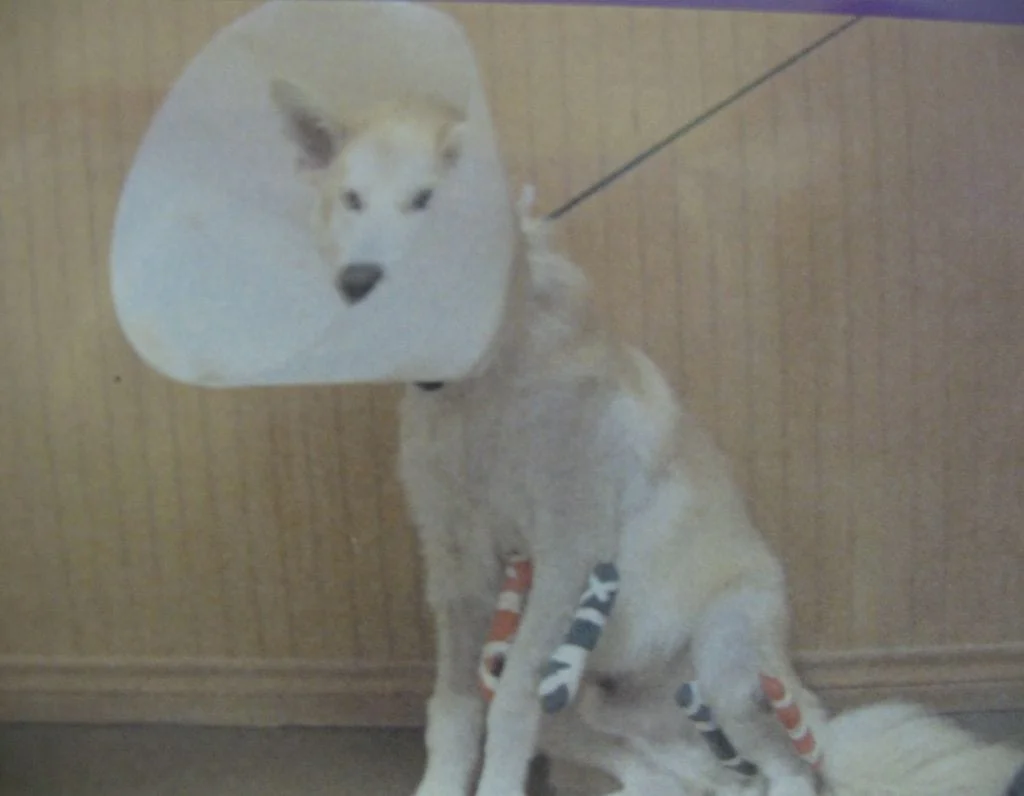
It comes to mind that cats are usually the creature of the nine lives tales but here at Whitehouse Veterinary Hospital, we think a certain six-month-old pup is definitely in that category. The pup we are talking about is Lukos; a beautiful, energetic wolf hybrid owned by Robert and Cherie Templin.We first made his acquaintance when Lukos presented with the nasty viral disease Parvo. Parvo, in out neck of the woods, is a dangerous, commin and often times fatal disease if not taken care of right away. Thanks to the efforts of his family, Lukos received the attention he needed and made a great recovery. As you might have noticed though, by the picture of Lukos that accompanies this article, he is in quite a different mess this time. Two months later, after wandering from his back yard, he was struck by a car and picked up by a Good Samaritan who took him home and cared for him. The Templins were frantic to find Lukos and heard that he had been hurt. The Good Samaritan and the Templins eventually met and Lukos was returned to his home, with somewhat of a hurdle to overcome. Lukos had sustained two broken legs, a fractured pelvis, various cuts and numerous bruises from his incident. In a 3 ? surgery session, Lukos had to have his left front leg and his left back leg pinned in order to stabilize the fractures. Through it all, illness and accident, Lukis has been one of our best patients. He is a loving and resilient young upu that will be one of our favorites for some time. We wish him and his family good luck in the future.
Pet of the Month
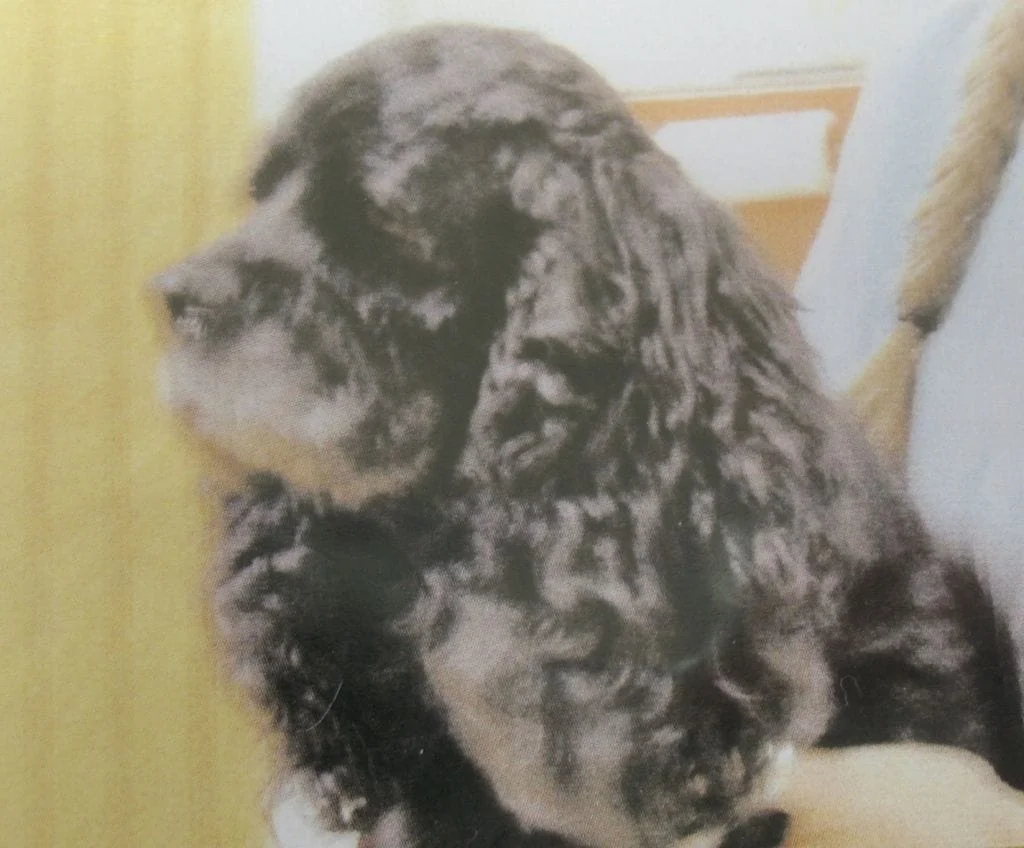
Lady is a 9-year-old black Cocker Spaniel who resides in Whitehouse with owner Catherine Ferguson. Ms. Ferguson owns and operates Mommas House, a local day care center. Ms. Ferguson has 3 other dogs; Gus, Hank, and Mickey. Mickey is lady?s favorite and they go everywhere and do everything together. Lady is being treated by Dr. Reese for Keratoconjunctivitis Sicca, which is the drying and inflammation of the cornea and conjunctiva. Ms. Ferguson applies and ointment to Lady?s eyes at least twice daily to keep them moist. What Ms. Ferguson loves most about Lady is that ?she is very lovable and likes to cuddle?. Lady is a very special dog; as blind as she is, she still loves to run and chase cats and can still grab treats from your hand. Last Valentine?s Day Lady got out. Ms. Ferguson thought she would be run over because she cannot see. It had snowed all day and all night, but a special lady called to tell her that she saw Lady in the pasture among the cows and brought her home. Ms. Ferguson says ?It is wonderful to have her.
Pet of the Month

Ali is a 16-year-old male cat who resides in Arp with parents D'Ann and Wayne Rauh. The Rauhs Have other pets, including two more senior cats; Furball, who is 20-years-old and Street People, who is 19-years-old. These cats have lived all their lives with the Rauhs. What Mrs. Rauh loves most about her pets is when you need a hug they are always there. Ali is the man with an attitude of the bunch. He was treated last year by Dr. Reese at our hospital because he was sick and vomiting fairly often. With a special diet and medications, Ali is feeling much better. Furball is just a sweet little old lady and Street People is just sassy. Together they provide a constant source of amusement for the Rauhs.
Pet of the Month

Meet Murphy, a 9 year-old West Highland terrier who has been a patient of ours since he was a puppy. Murphy is a typical Westie and is a spunky, happy little dog. He rules the roost at home, keeping several German short-hairs in line. Unfortunately, he was accidentally run over following his owners' car too closely in the driveway. It was after-hours and we were already closed so they took him to the Tyler Animal Emergency Clinic. They performed x-rays and found Murphy to have a fractured pelvis. The ER clinic treated Murphy for shock and the owners transferred him to our hospital the next morning. Overall, he was doing well despite his injuries. Sometimes a fractured pelvis can heal on its own with just cage rest and time, but Murphy's fractures were more extensive and required surgery to heal. We forwarded Murphy's x-rays to Dr. Ballow for review. Dr. Ballow is an excellent traveling orthopedic surgeon who works in East Texas. Dr. Ballow said he indeed could perform the surgical repair on Murphy's fracture and stabilized his pelvis with a screw. Since his surgery on April 6th, Murphy is doing well and beginning to use all four legs, but is still on restricted activity. He should be back to bossing his other dogs around in no time with just a little more swing in his gait. His prognosis is good; though he will probably have to take arthritis supplements in the future. We are thankful to Dr. Ballow for helping us help one of our favorite patients back on the road to recovery. Get well soon Murphy!
Pets of the Month
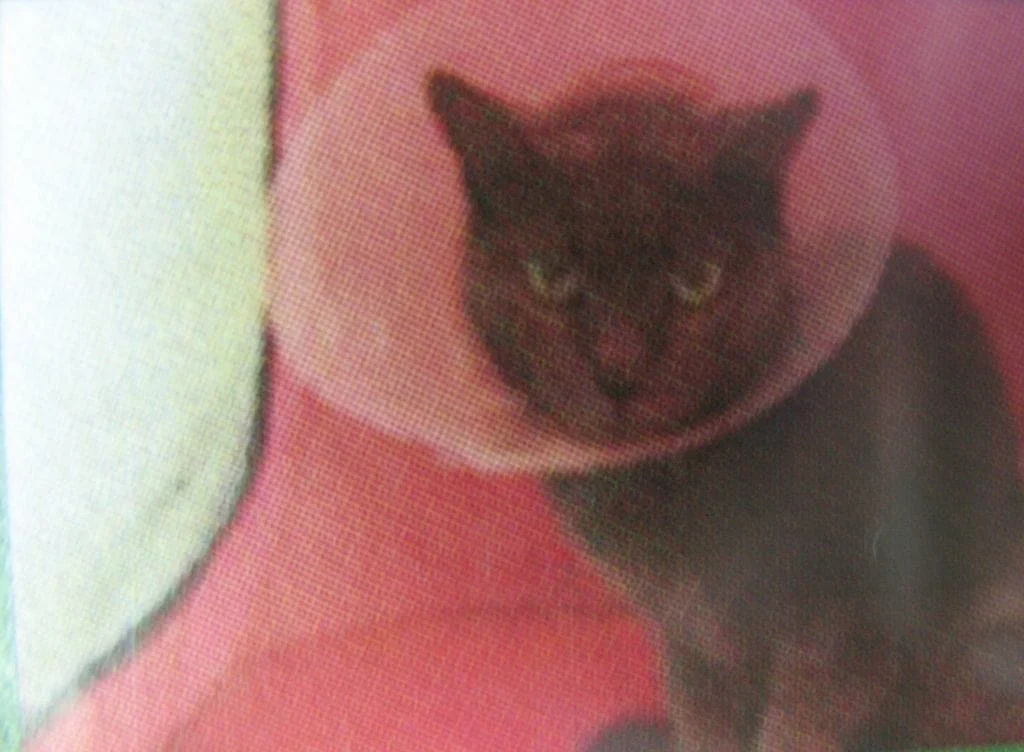
Prizzy is an 11 year-old smokey gray kitty. We first saw her in November for a swelling her owner noticed on her side. Dr. Reese diagnosed Prizzy with a 'cat bite abscess', which is an infection under the skin following a bite by another cat. The best treatment for an abscess of this type is to lance and flush the wound. Most of the time a drain is placed in that area so it can continue to drain for a few days while the infection clears up. Prizzy had a very large area on her side and abdomen where the abscess had occurred. Unfortunately, an area on her stomach failed to heal and began to slough or die.
She stayed with us for several weeks while we treated her in the hospital with daily hydrotherapy, cleaning and flushing of the wound. The next step to make her better was to suture the area where the dead skin was; kind of like a tummy tuck. Prizzy did well for surgery and recovered nicely. All throughout her treatment and recovery she was patient. For a kitty to be put in a bathtub twice daily, with water sprayed on her tummy (hydrotherapy) and no one on staff being maimed or injured is saying a lot for her tolerance! We enjoy seeing her and Mr. Hubbard when they come in for rechecks or boarding. Glad to see you are feeling better Prizzy!
Pets of the Month

And for our second shining star we applaud Jade Willard for a speedy recovery after extensive surgery to remove foreign materials from her stomach and small intestine.
The Willards brought Jade to us in early December with gastrointestinal problems. She had stopped eating, was vomiting and had diarrhea. Upin examination, Dr. Reese found Jade's abdomen to be painful and he recommended blood work that could rule in or out any gastrointestinal infection or inflammation. With the completion of the blood work, pancreatitus, a common disease in canines was confirmed. Jade was kept overnight for observation and specific Pancreatic treatments that consisted of I.V. fluids, anti-diarrheal/anti-nausea medication as well as broad-spectrum antibiotics. The next day she was fed small meals to make sure she could eat without vomiting and with the consent of her owners, Dr. Reese prescribed medications to treat the symptoms of pancreatitus and she was sent home.
Jade did well that night, but was inactive the next morning and steadily declined throughout the next day. She did not eat that evening and was vomiting the next morning. She was brought back in and re-examined, at which time Dr. Reese recommended x-rays to look for possible foreign objects since pancreatic symptoms were not subsiding. X-rays indicated a possible gastrointestinal foreign object and Dr. Reese recommended surgery to which the owner agreed. During surgery a cloth material was found in her stomach and upon palpation of the small intestine another piece of foreign matter was found. After surgery our staff kept her under observation for a few days and then sent her home. With weekly re-checks and the loving support of her family, she has made a full recovery and is back to living life to the fullest!
Pet of the Month
Ladybug is a sweet little cockapoo that we have grown to love. She came to us one day not wanting to put any weight on her left hind leg. At first Dr. Reese thought she had possibly torn her ACL (anterior cruciate ligament). After a thorough exam however, it was decided that radiographs were necessary to confirm a possible hip injury. Radiographs were taken and confirmed our suspicions that Ladybug had indeed injured her hip and was suffering from coxofemoral luxation (or dislocated hip). After a very tedious surgery to reattach the femoral head (the long bone of the leg) back into the hip socket, Ladybug is doing great. She was sore the first few weeks, but within a month was almost back to her normal, playful self. Before and after the surgery Ladybug was just so easy to care for. She has a wonderful personality, which played a key role in how fast she recovered. Thanks to the loving care of her owner and the medical care given by Dr. Reese and the staff at Whitehouse Veterinary Hospital, she is now pretty much 100% back to normal.
Pet of the Month

Casey Webber is a sweet, lovable mixed-breed dog. In August she was involved in a terrible dog attack. We initially treated Casey for shock and trauma with I.V. fluids, several different antibiotics and pain medications. Her x-rays revealed no internal injuries, but the attack left Casey with several lacerations and nerve damage to her left front leg. Dr. Reese cleaned, sutured and stapled Casey's multiple wounds. She was very uncomfortable for several days, but every day brought improvement. She went home with pain medication and antibiotics to guard against infection. Her human mom, Mrs. Webber, put in many hours taking care Casey while she was recovering and that really kept Casey's morale up. With much hard work from everyone, Casey was even able to regain some use of her damaged leg. Several months later, our dear Casey was doing great and nearly back to normal!
Pets of the Month

Fred Harris is a sweet and loving 9 year-old short haired Dachshund who is cared for by Steve and Karen Harris of Flint. She has two siblings at home to keep her company; Murphy, a cute shepherd mix and Otis (new to the family by way of ETARF), a long haired Dachshund. Fred came to the hospital in July 2009 for a routine checkup and during that, Dr. Reese found a small mass on her rump. Dr. Reese determined that removal of the mass was best and surgery was scheduled and performed soon after. The surgery was performed without any complications and the tumor sent in for testing. Within a few days a report was returned and what was thought to be a fatty tumor turned out to be grade 2 cancer.
Fred was put on a corticosteroid for several months and at the end of the treatment regimen she will be brought in for x-rays to make sure she is clear of any tumors. She's been a trooper so far and we wish her the best of luck in her progress!
(UPDATE: Fred's x-rays showed her to be tumor free and has been given a clean bill of health!)
Pets of the Month
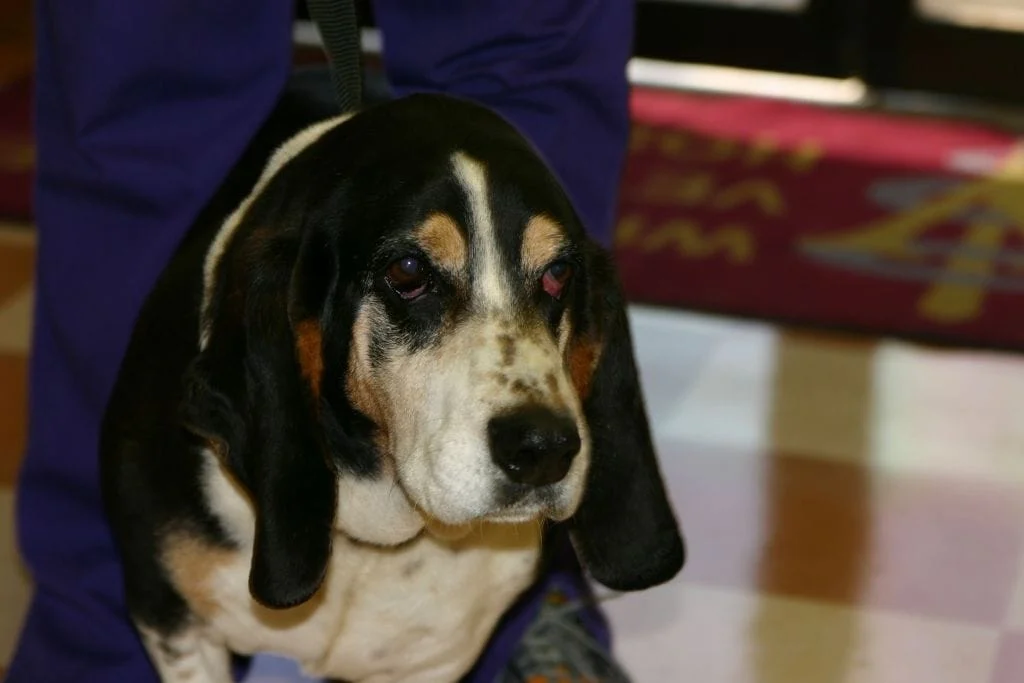
Balthazar Reese is a good ol' 9 year-old Basset Hound who happily lives with Pete and Jackie Reese here in Whitehouse. Balthazar shares his home with two other siblings; Cisero, an orange cat and Ophelia, another adorable Basset. Balthazar came into the clinic in December with a small, inflamed granulation wound on his tail head. It was clipped down and treated at home for a couple of weeks. Three months later the wound was still present and surgery was recommended to remove the inflamed tissue. Surgery was performed at the end of February and the tissue was sent in for histopathology. Lab results confirmed the tissue to be cancerous, but with the removal the risk of it spreading was minimal. Balthazar is quite the happy camper to this day!
Pet of the Month

Nick is a very sweet 4 year-old Chihuahua. His mom brought him to us one morning after another dog attacked him. He was in shock, had several puncture wounds and a possible hernia. We placed an I.V. catheter, gave medications to treat his shock and pain medicine to help make him comfortable. Later that day, we took -rays to rule out any fractures and confirm Dr. Reese's suspicion of a hernia. A hernia is when an organ or part of it protrudes through a defect in the body cavity that contains it. Nick's condition stabilized throughout the day and we were able to schedule his surgery for the next day.This was to repair his puncture wounds and abdominal hernia. First we cleaned and sutured his wounds, then focused on repairing his abdominal hernia. There was, however, a little surprise; the small lump on his right side which we initially thought was muscle damage associated with the abdominal hernia was actually his right kidney protruding through the hernia.
The hernia repair went well and lucky for Nick there was no serious damage to his organs, including his right kidney. Prognosis was good for a full recovery. Nick did well overnight and was wagging his tail by morning. Nick was such a wonderful patient despite being scared and in pain. He never once complained and was always willing to give kisses. We love you Nick and are so happy you're all better!
Pets of the Month
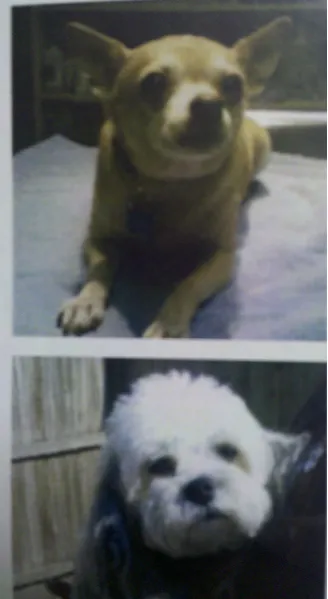
This time we have two very special patients we'd like to feature. Chester Russel is a 10 year-old chihuahua and Harpo Horton a 3 year-old Cabashon (sort of like a Bichon). Both came in a few months ago with similar symptoms of rear leg paralysis and back pain. After examination and x-rays, Dr. Reese determined both to be suffering from Invertebral Disc Disease or I.V.D.D. This is usually caused by acute trauma to the spinal cord causing disc herniation and spinal cord compression. Treatment can vary depending on severity of the disc extrusion. Conservative treatment can be steroid therapy, strict confinement, and physical therapy. The best option for a paralyzed pet is surgery. Both Chester and Harpo were referred to Dallas Veterinary Surgical Center for treatment and surgery. Both are doing well and able to walk normally.
Pet of the Month

Seymoure is a happy-go-lucky, year and a half old poodle mix who resides with his pet parents Mr. and Mrs. Middleton. He came to us in May after being attacked late one night by coyotes. He had multiple deep lacerations on his abdomen and neck. He was very brave, never once complaining or showing that he was in any pain. After numerous stitches, staples, drains, and weekly visits to monitor his healing process, Seymoure was able to go back home to his family. It's been a long road and has taken him a lot of time to recover, but he is back to his old happy, fun, loving self. Thanks to Seymoure and his family for trusting us to care for him, it makes what we do so rewarding.
Pet of the Month

Many weekends you can find Ringo boarding at our hospital when his owner is out of town. Not because he gets into mischief at home, but because he requires twice daily insulin injections. Ringo is a 14 year-old, neutered black cat. He was brought to us on August 21, 2008 with significant weight loss, increased thirst, loss of appetite, increased dandruff and dehydration. Dr. Reese did a full physical exam with a complete CBC/Chemistry panel. While waiting on the blood results we placed and I.V. catheter to help the dehydration and hospitalized Ringo for the night. The next day his blood results showed a very elevated blood glucose and glucose was even found in his urine. Dr. Reese diagnosed Ringo with Diabetes Mellitus. There are two types of DM, one caused by an insulin deficiency and the other is where the body produces enough insulin but is not responding to it. We immediately started Ringo on insulin twice a day and a special diet. His owner had to start giving injections at home. Since his diagnosis we have been rechecking his blood glucose regularly to make sure he is getting the appropriate amount of insulin. Now his weight is up, his coat is healthy and he is a very happy kitty.
Pet of the Month - January 2009
Sammy Rauh came to our office in November with severe breathing problems. He is a 4 year-old orange domestic short-hair cat who was recently diagnosed with Bronchitis and Acute Respiratory Distress Syndrome. This meant the Sammy had a lot of trouble breathing.
Bronchitis is a chronic cough and Acute Respiratory Distress Syndrome is the onset of a respiratory failure. Dr. Reese started Sammy on broad-spectrum antibiotics, controlled the fever and also started breathing treatments twice daily. He ran blood work, tested for feline heartworm disease and took radiographs which helped diagnose the Bronchitis. Sammy was also tested for common viruses, which included Rhino Pneumonitis and Calicivirus. Sammy tested positive for Rhino Pneumonitis, which is a common upper respiratory virus that can be severe but is preventable with a yearly vaccination. We also tested for the fungus Cryptococcus, which was negative. After a two-week stay Sammy, who was much improved, was sent home with antibiotics and steroids. Today Sammy is back to being himself and feeling great.









